JOE PATERNO -
THE HERO WHO FELL OFF
THE PEDESTAL
Written by
Rick Archer
August 2012
This is a story about Joe
Paterno, the famous Penn State college football
coach.
In
November 2011, Paterno suffered the most
serious fall from grace since Richard Nixon. The
difference between Nixon and Joe Paterno is that we
all suspected that Nixon was a crook.
Paterno,
on the other hand, had a
sterling reputation. Excerpt for a few insiders, no
one could ever have
anticipated Paterno’s fall from the pedestal.
When it happened, the story was beyond bizarre and
the shock was unbelievable.
|
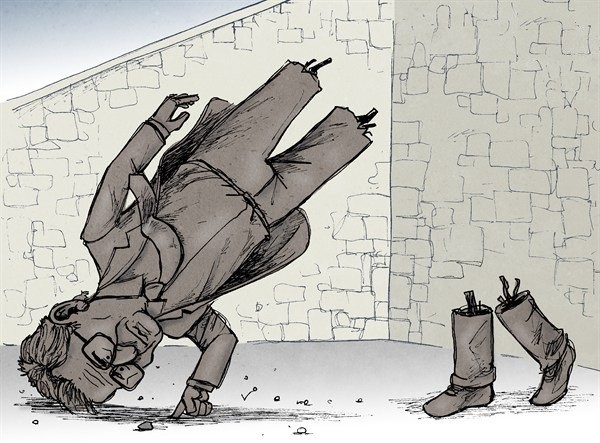 |
|
| |
|
THE PENN STATE WAY
Before we get
started on what Paterno did wrong, let’s start with what
Paterno did right.
Joe Paterno was
the winningest football coach in major college football
history. As the unquestioned leader of the Nittany Lions,
Joe Paterno was nicknamed the
"Lion King".
In particular Paterno enjoyed credit
for winning the right way, "The Penn State Way". He
was said to run the cleanest program in college football.
Paterno's players were quite simply some of the finest young
men in America. They trained, they studied, they made
good grades, and they were terrific athletes. They
were the best and the brightest stars.
With 409
victories to his credit over the course
of his celebrated career, Paterno
had grown to become
something akin to a mythological
hero on the Penn State campus. He
was widely admired and revered.
There is no
simpler way to say it: Joe Paterno was Penn State.
|
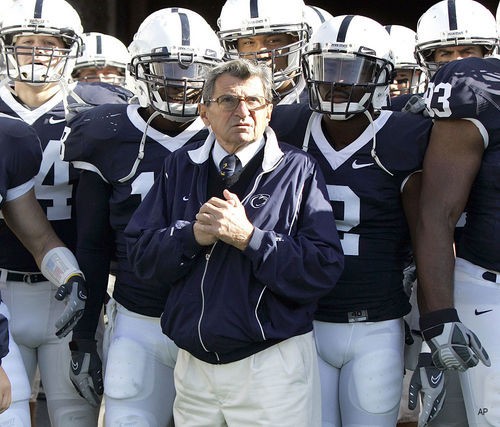 |
A
LOOK BACK ON PATERNO'S CAREER
Successful,
stubborn and highly principled, the Brooklyn native served
as head coach of the Nittany Lions for a staggering 46
years. This made him the longest-serving head coach in the
history of college football.
Even more
remarkable is the often-forgotten fact that Paterno was a
Penn State assistant for 15 years before taking the top job.
In other words, he spent a full 62 years--his entire
professional life--in Happy Valley, helping transform a once
tiny university into both an academic and athletics
powerhouse.
In his time at
Penn State, Paterno literally put Penn State on the map. He
picked up two national championships, won more bowl games
than any other coach, had five undefeated
seasons and was named National Coach of the Year five
times. He compiled a career
record of 409 victories against just
136 losses and 3
ties.
Moreover, as any Penn State
partisan will point out, Paterno was always about much more
than just football. A graduate of Brown University, Paterno
always insisted that his Penn State program emphasize to
players that college should be about education, not just
football. Early in his career, he introduced the so-called “Grand
Experiment,” his plan to build a program that would
excel both in the classroom and on the field.
Paterno
succeeded. Not only did his teams win a whole lot of
football games, they routinely posted some of the best
graduation rates in all of college football.
Not only did the
players graduate, they excelled as student-athletes. The New
American Foundation ranked Penn State No. 1 in its 2011
Academic Bowl Championship Series.
Penn State's players have consistently demonstrated
above-average academic success compared to Division I-A
schools nationwide. According to the NCAA's 2008 Graduation
Rates Report, Penn State's four-year Graduation Success Rate
of 78% easily exceeds the 67% Division I average.
Among Big Ten institutions, Penn
State's athletic graduation rate was second to only
Northwestern
Nor did
Paterno care about skin color. Every player was
important to him. In 2011, Penn State football
players had an 80% graduation rate.
There was no achievement gap between its
black and white players, a rare feat for Division I
football teams.
Paterno
was also renowned for his charitable contributions
to academics at Penn State. He and his wife Sue
contributed over $4 million towards various
departments and colleges.
After
helping raise over $13.5 million in funds for the
1997 expansion of Pattee Library, the University
named the expansion Paterno Library in his
honor. Furthermore, in appreciation for his
accomplishments, a life-sized statue of Paterno paid
for by a group of alumni was placed outside the
athletic building in the late 1990s.
Joe
Paterno was not just a living hero to the people at
Penn State, he seemed like the best of the best to
the world. Everyone agreed Paterno was an
enlightened leader. He cared about his football
players like his own sons. Paterno did things the
right way.
|
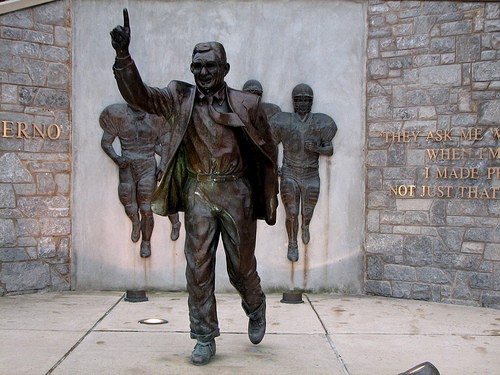 |
|
| |
|
MY PERSONAL VIEW OF JOE
PATERNO
Up till now, for my entire adult life, I
participated wholeheartedly
in the admiration of Joe Paterno.
Thanks to my Uncle Dick,
I felt like I actually knew
Paterno
personally.
At the risk of
incurring great wrath, I will now admit I was born in
Philadelphia. Yes, I am a Yankee from Pennsylvania. Please
forgive me… I was at the mercy of my parents. I got down to
Texas as fast as I could, reaching Houston when I was six.
As part of my
Pennsylvania legacy, my uncles, my aunts, and my
grandparents were all Penn State graduates. No one on earth
was a bigger Paterno fan than my favorite uncle Richard,
the man for whom I was named. In many ways, Uncle Dick
was a better father to me than my own father.
Since Uncle Dick was a man I admired greatly, his
appreciation for Paterno rubbed off on me at an early age.
I went to college
at Johns Hopkins in Maryland back in the late Sixties. At
that point in time, Uncle Dick was now living in McLean,
Virginia, a heavily wooded suburban area outside DC where
all the CIA spies live. Since Baltimore and McLean were
only an hour apart by car, I
visited Uncle Dick and his family anytime I could on the weekends
and school breaks.
Those
visits were my salvation. Being so far away from
home, loneliness was a real problem, especially in the first
year. Uncle Dick and my beloved Aunt Lynn were the people
who kept me sane throughout college.
However, Uncle
Dick’s friendship carried a goofy price. I was subjected to
endless teasing about my fondness for the University of
Texas.
During my first two years in
college, those were the days when the Longhorns and the Penn
State Nittany Lions were the two best teams in the country.
Penn State was
undefeated in 1968 and 1969, my first two years in college.
The University of Texas, my favorite team, was doing pretty
well themselves. The Longhorns went to the Cotton Bowl six
years in a row.
During 1968, my
Freshman year, Penn State and UT
were neck and neck in the college rankings all year long.
Penn State finished 11-0. UT finished 9-1-1.
The final poll was 1.Ohio State 2.Penn State
3.Texas.
Throughout the year, every time I visited, Uncle Dick showed
me no mercy. He would constantly compare the football
fortunes of our two rival universities and gloat that Penn
State was ahead of UT.
As bad as 1968 was, 1969 was even worse. In 1969, both
teams went undefeated. Since both teams faced quality
opposition, there was really no reason anyone could say one
team was better than the other. However, the sportswriters
placed UT just barely ahead of Penn State in the polls all
year long much to the anguish of my uncle.
Historically, there was a perception that Paterno was not
well-liked by the media. Uncle Dick was convinced this
bias explained why Penn State trailed UT in the polls.
Unfortunately, the two teams never met that year to decide
the issue. The results of the bowl games would decide
who was the champion. I will never forget the Cotton Bowl that
year when UT played Notre Dame. There was a lot of
national interest in the game. If the Longhorns lost,
then Penn State would have become the national
champions.
Uncle Dick was very hopeful. Notre Dame was loaded
with talent and he was certain that UT was over-rated.
When the Cotton Bowl
game came on TV, the whole family
rooted with passion against my Longhorns.
It was me against the world that day.
Uncle Dick rooted against the Longhorns. Aunt Lynn
rooted against the Longhorns. Any time the 'Horns made
a good play, they would glower at me as if it was my fault.
I had four
cousins. They all rooted against UT.
Boo, Longhorns! Boo, Rick, our stupid cousin from Texas! If your team
wins, we will make your life so miserable you will have to
drive back to college early just to escape our wrath.
I think they even
taught Beauty the collie dog to
boo as well.
To my joy, Yes, my team won… in 1969, UT defeated Notre
Dame 21-17 thanks to a last minute touchdown
by Cotton Speyrer. However, for survival purposes, I
kept my joy under careful wraps. I was still hoping to
eat with the family at dinnertime.
The victory assured that the
University of Texas would
become the National Champions.
My uncle's house was
glum. No joy in
mudville. No joy in McLean.
I was held
personally responsible. I think I slept in the doghouse
that night. It was an uneasy sleep; don’t forget the dog
rooted for Penn State too.
Eventually I was forgiven. Fortunately for me, UT
had an off season the next year
and Penn State was
clearly the better team. To my
relief, Uncle Dick eased up on
the teasing. At this point Uncle Dick
began to tell me why he loved Penn State so much.
He had incredibly fond memories of Penn State.
I listened to him explain how proud
he was of his wonderful Penn State.
It is
incredible to realize how important Penn State takes
its football. I guess anyone who lives in Texas can
understand “loyalty” to a football team… and not
just UT, but Texas A&M, University of Houston, and
all the other great Texas schools. Pennsylvania is
equally crazy about its school.
Penn
State has sold out its stadium of 108,000 since the
beginning of time. Football is that important.
Their entire culture is wrapped around Penn State
football. Therefore, no one is more important than
Joe Paterno, the legendary coach of the Nittany
Lions.
|
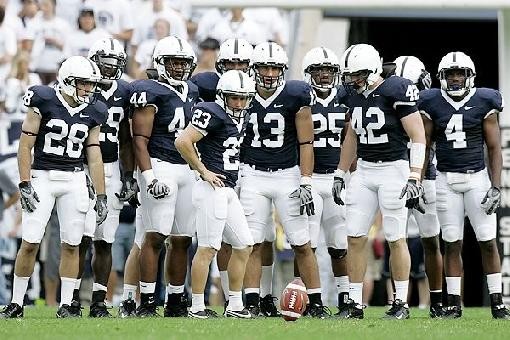 |
As Uncle Dick
explained it to me, the thing he was most proud of was the
fact that Joe Paterno ran the cleanest program in college
sports. His football program had never been investigated
for under-the-table payments to college athletes. His
program had the highest graduation rate. His players only
rarely got into trouble with the law. Paterno’s teams
played hard but fair. No cheap shots. No bounties on the
quarterback. Paterno said win fair and square or the game
isn’t worth playing.
Penn State
players were among the finest student-athletes in the
country. Not only did they play
hard, they went to class, they studied, and they were great
kids. In a nutshell, the Penn State program reflected the
high moral caliber of Joe Paterno, the coach. Penn State
was regarded as the best run program in college football.
The very name “Penn State” came to symbolize “integrity” in
the world of college sports.
Uncle Dick would
point out that Penn State football had a terrific winning
record by doing things the right way. While all sorts of
schools regularly got in trouble for violations – USC,
Miami, Ohio State, Oklahoma – Penn State was clean. Penn
State was so good they didn’t have to cheat.
Penn State had it
all – great coach, great athletes, great attitude. Uncle
Dick was so proud of his school and its football team that
he regularly donated money to the school. He wasn’t the
only one. Donations to Penn State were regularly among the
top ten colleges in the country.
And, in Uncle
Dick’s opinion, they owed it all to Joe Paterno.
As the years
passed, I heard nothing to contradict my uncle’s claims.
Every year Penn State won most of its games and every year
Penn State stayed out of trouble.
A longtime subscriber to Sports
Illustrated, the magazine appeared to worship Joe Paterno.
Not a bad word was ever written about the guy.
Considering that
all the other major programs had constant issues, I was
impressed.
Like a lot of
other people, I admired Joe Paterno.
|
| |
|
JERRY SANDUSKY
And then it all
fell apart. When the news broke in
November 2011, I was absolutely stunned to realize
that Joe Paterno had knowingly allowed a sexual monster
named Jerry Sandusky to prey on little boys inside
his own athletic department. The reports
suggested Paterno had allowed this to continue for
one reason – Paterno did not want the pristine reputation of
his magnificent program sullied by this horrible stain.
Paterno may have known about
Sandusky's secret as far back as 1998. Now,
thanks to Paterno’s neglect, Sandusky
had gone
on to molest at least 6 other boys
that were reported and who knows how many that went
unreported. Worse, Sandusky
had repeatedly used the facilities
of Penn State football program to molest the children. This
insanity appeared to take place
right under Paterno’s nose.
Many writers said not to listen to
all the flimsy denials that Paterno didn’t know what was
going on. Nothing gets by Paterno. He knew something
wasn’t right, but he let it continue. Paterno not only
actively participated in a cover-up, he allowed the lives of
these poor helpless boys to be ruined.
If that was the truth, it
was unforgiveable.
|
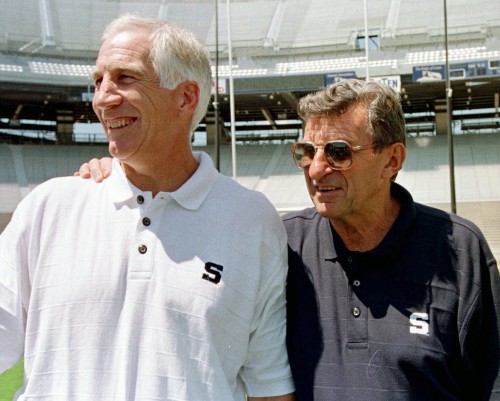 |
| |
THE THREAT OF PEDOPHILES
I
was
astonished. I was shocked. I
was disgusted. How
could a man
like Paterno who had
established himself as an unquestioned paragon of moral
decency allow this to happen?
I was shaking as I read the story. I
didn't understand the intensity of my anger. Why was I
so upset?
Then it occurred to me I had some
first-hand knowledge about the problem.
I nodded to myself. I had just figured out why I was
so mad.
When I was a
little boy, I was molested on three separate occasions.
Each incident involved a strange man coming up to my side in
a public swimming pool and putting his hands inside my
bathing suit.
I was 11 the
first time it happened. An adult
man swam up to me at the neighborhood public swimming pool
in Dunlavy Park. He engaged me in a
conversation. About three minutes passed as I politely
answered his questions. Then without warning, he
slipped one of his hands inside my suit. I remember
clearly what the man said. “Do you like that? Does
that feel good?”
What he was doing didn’t feel good
or bad. Looking back, at least the man was
being careful not to hurt me.
However, I did think what he was
doing was way out of the ordinary.
I tried to decide whether what he was
doing was okay or not.
The thought crossed my mind that all the
boys in my Fifth grade phys ed class walked around naked in
the locker room on our way to the showers. Therefore I knew
it wasn’t wrong for boys to be naked together. So maybe it
was okay for boys to touch boys or men to
touch boys. But this was something I did not enjoy,
so I asked politely permission to excuse myself.
I remember saying, "Excuse me, but I have to get home now."
How ridiculous. I was being polite to a man who was
molesting me. Well, I had been trained at school to be respectful to
adults. I swam away and departed
the pool on the other side.
When I got home,
I told my mother. Mom was incensed. She told me what that
man had done was wrong. She forbade
me to go back to the
swimming pool down the street. I protested. Going swimming
was my favorite activity during the summer!
Finally my mother
relented, but not without a warning. Mom said that if it
ever happened again, call the lifeguard.
Two months later,
the same thing happened. I am blind in my left eye. While
I rested on the edge of the pool, a man snuck on me from my
blind side. This guy had a different
style. No conversation with him. He just grabbed
me. His hands were in my swimming trunks before
I even knew he was there. This guy was
also meaner than the first
man had been. He groped and leered and grinned. He was
obviously pleased with himself and laughed. This guy scared
me. I called out, “Lifeguard! Lifeguard!”
That worked. Not
only did my attacker release his powerful grip, he jumped
out of the pool in a hurry. I noticed that two other men
from other parts of the pool did the same
thing. These perverts
had been cruising the neighborhood pool
together. They didn’t waste any time making their
getaway. The last thing I saw
was all three of them
laughing and trotting down
the street. It was a game to them.
This time I was mad. The man had physically hurt me and I
ached from his squeezing.
The lifeguard
came over to ask what had happened.
Now that my mother had explained this was wrong, I was
too ashamed to tell him, but I
think he knew. Heck, he was just a teenager himself. What
was he going to do about it?
I got my towel
and left. My mother was right.
I never went back to that pool.
This happened one
more time. I was 13. My mother was visiting a girlfriend
and I was allowed to use the woman’s apartment swimming
pool. I was alone in the pool when two teenagers and one
man came sprinting out of one of
the apartments. That was strange.
Why were they running? To my surprise, they headed
straight for
the pool and dived in on the run.
I remember distinctly that
one of the boys had an erection although I was still too
young to know what that meant.
I was instantly
on alert because everyone had
strange flushed expressions on
their faces.
Despite my
attention, nevertheless I fell prey to a dirty trick. One
of the boys came over to talk to me. He wasn’t much older
than I was so I wasn't afraid. He
asked me where I was from and what
school I went to. While I was talking to him, the
adult man snuck up from
behind me. Suddenly
I realized he had both hands in my trunks. I
screamed at the top of my lungs, “Stop it,
Mister!” That worked. The man recoiled
in surprise at my anger. At 13, I
wasn't quite so defenseless any more. I was ready to
kick and holler if necessary.
All three of them headed out of the
pool as fast as they could and I did the same thing.
I ran to the apartment. I told my mother
who absolutely nuts. She and her girlfriend stormed
out to look for them, but
they were long gone.
I felt humiliated.
It is almost impossible to defend
against this kind of hit and run tactic. I
can't begin to describe how upset my mother and her
girlfriend were, but this time my anger nearly matched
theirs. I felt violated.
I was fortunate.
In the cosmic scheme of things, this was
nothing. I did not suffer
any negative effects. Nor did I grow up
hating gays. I am smart enough to know there are good
people and bad people in all walks of life. As far as I am
concerned, what consenting adults do behind closed doors is
their business. It is the child molesters I hate.
I would like to add that the gay
people I know are just as disgusted by
this kind of sick behavior as straight people
are.
For that matter, this kind of
predatory behavior includes so-called
heterosexual men who attack little girls. These
abusers
are just as much monsters as their aggressive homosexual counterparts.
When I was 23, I actually met two
hetero child molesters through my job investigating child
neglect and abuse. Most
people are not aware I worked for Child Welfare for four
years. I had two heart-breaking cases where little
girls were raped by their stepfathers. One girl was 12, the
other was 14. Neither man was prosecuted because both
times the mother refused to file charges. Frustrated,
relatives of the little girls called Child Welfare to report
the situation. I definitely investigated, but without
the mother's help, I could do nothing but write up the
he-said, she-said details for the case files. Mostly I
wrote down all the denials and protests of innocence.
If you could have met these men, you
would know they were lying every time their lips moved.
Looking back, I
think those childhood experiences and my
Welfare experiences explain why I was so angered by
Paterno-Sandusky. I learned the hard way
that there are predators
everywhere. Knowing first-hand
how easily children can be exploited by adults, the outrage
I felt towards Joe Paterno had
practically no limits.
Why didn't he protect those poor kids?
I asked myself if I had the right to
judge this man.
They say he who is without sin may throw the first stone.
Well, I am far from perfect, but I know enough about right
and wrong to step up and say it is WRONG
to knowingly allow a giant man
like Sandusky to operate in a position of authority.
Thanks to Paterno, Sandusky had the
perfect opportunity to take advantage of helpless
little boys and sexually abuse them.
Out of respect for my uncle and out of
respect for the previous reputation of Joe Paterno, I
decided if I was going to judge Paterno, I had an obligation
to first study the stories.
So now you know
why I took a special interest in this story.
Before we continue, I have one
warning. My personal tale was just the warm-up act.
The stories that will follow are so horrible that you may
well get seriously upset. Just be forewarned this
article is not for the naive or the faint of heart.
Sandusky
was the sickest of the sick. I am
disgusted with Sandusky. The worst predators are the men who
deliberately seek positions of trust where they have
open access to young, impressionable children.
Sandusky fits the profile.
Through
Second Mile, his charitable
organization, Sandusky was constantly in contact
with unprivileged kids from broken homes. The boys
that Sandusky abused were extremely lonely,
physically helpless and emotionally dependent kids.
These
were typically fatherless little boys who were so
desperate for attention that they submitted to
Sandusky’s atrocities without protest. How sad is
that?
Sandusky is a mentally ill deviate who could not
control his urges. Lock him up and throw away the
key.
|
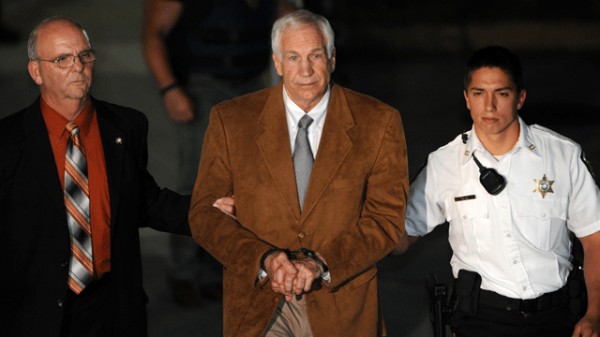 |
That said, I
am far angrier at Paterno
than Sandusky.
Paterno
is a far different story. Paterno wasn’t sick. He
clearly knew right from wrong. How was it ever
possible for Paterno to sleep at night knowing this
monster was on the loose on his watch? Didn’t the
safety of those helpless boys ever cross his
conscience? How could Paterno remain so oblivious
to their suffering?
Paterno is Catholic. While
Sandusky carried on his reign of terror in the early
2000s, stories of Catholic priests molesting little
boys in a manner similar to Sandusky broke on a
regular basis.
Paterno had to see the headlines telling the
stories of the little boys coming forward to say
their lives had been ruined by the Catholic priests.
How could he remain oblivious to what was going on
in his own domain?
As you will soon see, Paterno
knew full well what Sandusky was up to.
Sandusky was not only caught in 1998, he was caught
again in 2001. Paterno was informed both
times. How could Paterno possibly turn a blind
eye to the plight of these children?
By enabling Sandusky, what
Paterno did was so wrong that I find
myself almost helpless to
explain his behavior. How
could a man I thought was a hero suddenly turn into
such a callous human being?
I wrote this article for
one specific reason – I wanted to
know everything there was to know in print about
Paterno. I wanted to try to understand why
a man I once admired took the wrong
path.
|
|
| |
|
COVER-UP
I cannot help but
compare the Penn State scandal to the Catholic Church sex
scandal. There are several painfully apparent similarities.
In the case of
the church, it came to light in the early 2000s that the
church harbored serial sex offenders. From their exalted
position of trust and power, the priests used their special
access to youth to abuse the boys and commit heinous crimes.
Making the
problem even worse, rather than deal with this vast problem
openly, the Catholic Church went out of its way to hide the
problem. By transferring the priests to another location,
precious little was done to stop these pedophiles and
protect more children from abuse.
Jeff Anderson, a
lawyer who has successfully represented sexual abuse victims
against clergy, said these predators benefited from a
culture of insularity.
"From low-level administrators to the
top level, they looked the other way, and when they did see
something, they chose to remain silent."
|
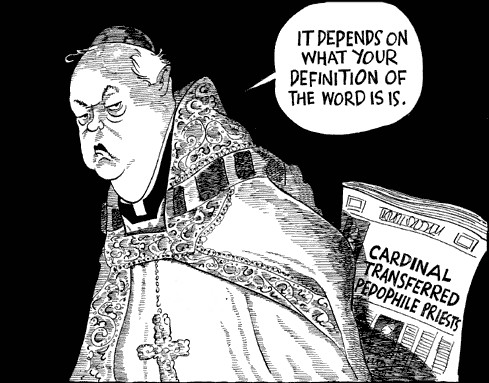 |
Referring to both
Penn State and the church, Anderson added,
"When the allegations are revealed and
reported and made known multiple times, there's a deliberate
decision to protect the institution and reputation at the
peril of the children."
Adds David
Clohessy, director of Survivors Network of Those Abused by
Priests,
"When allegations are raised, the
scales always favor the person with authority. Usually
child molesters are charismatic, lovable folks on the
outside. Priests are endowed with so much mystical
authority, no one dares believe the unthinkable.”
Most victims are
well aware of this. They feel – rightly so – “I won't be
believed; he'll be believed. Surely I’ll be abused and
bullied by his defenders. They'll call me
a liar. They'll say I'm the real pervert and lying to
protect myself. And even if I succeed in being
heard, I will be blamed and hated for having
a well-liked man sent away.
Why even take the risk? It's
a hell of a lot easier just to keep my mouth shut and get on
with my life."
Well-spoken. Silence is of course the
route taken by most victims. Who can blame them?
Women who have been raped say much the same thing - the
search for justice comes at great cost to the victim.
Nevertheless,
some victims have the courage to step forward. They are so
angry and humiliated that they are compelled to seek justice
no matter what the consequences. If they are lucky, they
will find someone who is willing to give them a voice.
That’s when things get interesting.
When this
happens, Institutions always lean toward self-preservation.
When a member of an institution has done something wrong,
the instinct of other members within that institution is to
sweep it under the proverbial rug as quickly as possible.
Many times their jobs are at stake
too. If this guy goes down, maybe they will too. For
example, everyone at Sandusky's charitable organization
ALWAYS looked the other way including the many attorneys who
were consulted. Those lawyers picked up their checks
and said nothing.
On a whim, I decided to see what ever
happened to Sandusky's charity. Read for yourself.
Second Mile
calls off plans for probe
August 02, 2012
Jeremy Roebuck, INQUIRER STAFF WRITER
The troubled youth charity
ensnared in the Jerry Sandusky child sex-abuse
scandal has called off plans for an internal
investigation, the nonprofit's chief said.
The decision this spring to close the Second Mile
has eliminated the need for an exhaustive inquiry
into what past leaders knew and when, said chief
executive David Woodle, who has led the organization
since the arrest of the former Penn State University
assistant football coach last year.
"We're in a different situation now," Woodle said.
"We're getting ready to go out of business."
What a surprise - no probe. Of
course not. Certainly several people at Second Mile
knew or strongly suspected the truth for many years and did
nothing. We wouldn't want to embarrass them, now would
we?
When the
institution is at risk, every member feels at risk. Now
the temptation to conduct a cover-up
appears.
The scandals that
have wracked the Catholic Church in recent decades are too
many to name. But every time allegations surfaced, the same
pattern of institutional self-preservation came to the
forefront. The same power asymmetry between the abuser and
the abused exists, and the same scarcity
of forthcoming candid information
exists.
By closing ranks
and limiting the flow of information, a well-executed
cover-up can spare the institution excruciating humiliation
and condemnation for years, perhaps even permanently. One
need look no further than the tobacco industry which hid the
health hazards of smoking for decades to see that billions
of dollars can ride on a successful cover-up.
There are suggestions that
cover-ups in the medical and pharmaceutical industries are
commonplace. Who is the hospital going to favor - the
bungling doctor or the damaged surgical victim?
So, in the case
of Paterno, I believe the simple answer is that he covered
up the existence of the monster to protect his own pristine
reputation and to protect the huge money-making football
program from costly shame.
However, in
Paterno’s case, the moral of this story does not ultimately revolve around
the benefits of a successful cover-up, but rather the
incalculable damage that comes from an unsuccessful
cover-up.
If you invoke a cover-up and fail, then
you need look no further than the fate of Joe Paterno to see
what can happen.
Paterno is dead now. But life
after the scandal has become a daily living hell for the
other three men below. They each participated in
Paterno's cover-up because they thought that was what was
best for their institution.
It would be interesting to know what
their thoughts are now.
|
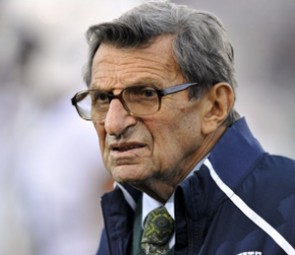
Joe Paterno |
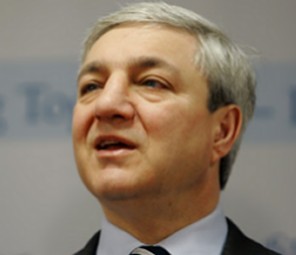
Graham Spanier |
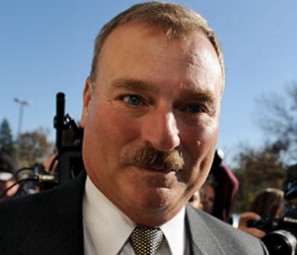
Gary Schultz |
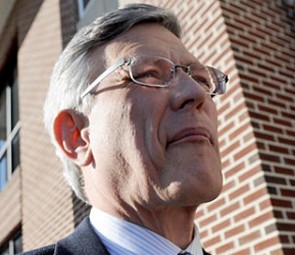
Tim Curley |
THE SANDUSKY GRAND JURY
As will
become increasingly clear, the interlocking sagas of
Sandusky and Paterno are overwhelmingly complex.
In 2008,
a high school teenager was called to the Principle's
office to answer a couple questions about Sandusky.
The boy broke down and began to sob profusely.
When he recovered, with his mother's encouragement,
he made a report about Sandusky. His story was deemed so serious that a Grand Jury
investigation was initiated. To the dismay of
many, under every rock in the state there seemed to
be another boy abused by Sandusky. They uncovered so much
horror that it took three entire years just to
follow up on all the leads.
They
discovered Sandusky had met every one of his victims
through the Second Mile foundation. The
Second Mile is a nonprofit organization founded in
1977 by Sandusky. Its primary mission was to serve
underprivileged youth and provide help for at-risk
children and support for their parents in
Pennsylvania. The charity said its youth programs
served as many as 100,000 children annually.
What we
now know is that Second Mile also served as
Sandusky's happy hunting ground.
When the
Grand Jury finally released its findings on November
4, 2011, it accused the longtime former university
football assistant coach of sexual assault on at
least eight underage boys on or near university
property.
The
Grand Jury released details on four separate
situations: the 1998 incident that began the
cover-up, a 2000 incident, a horrific 2001 incident,
and the story of the young man titled Victim 1 who
had come forward with the report that started the
wheels of justice rolling.
Sandusky
was indicted in 2011 on 52 counts of child
molestation dating from 1994 to 2009, though the
abuse may have dated as far back as the 1970s.
Seven of the counts included
involuntary deviate sexual intercourse, a felony.
In
addition to Sandusky, the Grand Jury also pointed
its finger at Head Coach Paterno and three members
of the Penn State administration. The Grand
Jury detailed the actions by certain university
officials to ignore the disturbing incidents,
thereby enabling Sandusky to attack more children.
In addition, there was evidence that suggested these
same officials had knowingly covered up Sandusky's
activities.
Per the
findings of the Grand Jury, Gary Schultz and
Tim
Curley were charged with perjury, suspended, or
dismissed for covering up the incidents or failing
to notify authorities.
In the
wake of the scandal, just days after the release of
the Grand Jury findings, Penn State school president
Graham Spanier was forced to resign, and head
football coach Joe Paterno was fired.
Meanwhile Sandusky maintained his innocence.
The trial of Jerry Sandusky on 52 charges of sexual
crimes against children started seven months later
on June 11, 2012, at the Centre County Courthouse in
Bellefonte, Pennsylvania. Four charges were
subsequently dropped, leaving 48.
On June
22, 2012, Sandusky was found guilty on 45 of 48
counts of sexual abuse. Sandusky would face a
minimum sentence of 60 years — effectively a life
sentence at his age.
Here is
a graph that might help keep all the names straight.
It reads like a Center for Disease Control chart.
In the middle is Sandusky and the misery spreads
from there.
Keep in
the mind the 13 names in red are all men who had
knowledge of Sandusky's activities and allowed him
to continue.
|
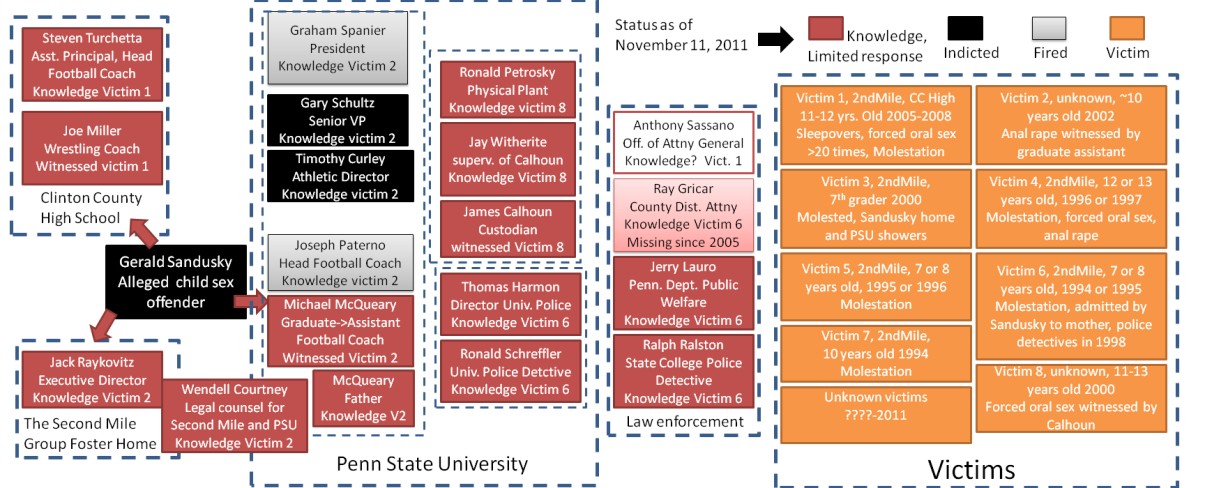
THE FREEH REPORT
When news of the
scandal broke the first week in November 2011, several key
Penn State administrators downplayed any knowledge in
Sandusky’s crimes.
Confronted by the media regarding the accusations in
the Grand Jury report, four Penn State officials -
Paterno, Spanier, Curley, and Schultz - all denied
they had any knowledge of Sandusky's activities.
In
particular, it was
difficult for the public to believe Paterno was
involved in this, especially since Paterno
vehemently denied any knowledge.
So who
should the public believe - the Grand Jury report or
the word of the most trusted man in college
football, Joe Paterno?
The Penn
State Board of Trustees weren't sure who to believe
themselves. They were suspicious that these
four men knew a lot more than they were admitting.
So the
Board decided to retain the services of former FBI
director Louis Freeh to find out the seriousness of
the problem. On November 21, 2011, trustee Kenneth
Frazier announced that Freeh would lead an internal
investigation into the university's actions.
|
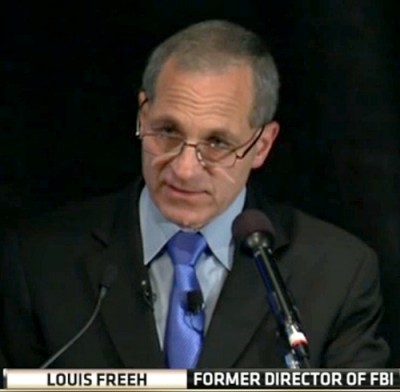 |
Freeh announced that the team assisting him in his
investigation would include former FBI agents and
federal prosecutors. To the credit of the
Board, Freeh and his team were given complete access
to any individual and any document they desired to see.
If
nothing else, Freeh and his team were thorough.
They
would take 8 months to conduct over 400 interviews
plus sift through countless documents and emails.
They were expensive too. With a $6.5 million dollar price tag,
it was tagged the most expensive "free" report
in history.
When the
Freeh Report was released in July 2012, the results
were far worse than even the worst pessimist could
have imagined. Putrid pus and noxious slime oozed
from every dark corner touched by Paterno, Spanier,
Curley and Schultz
The
Freeh Report completely concurred with the Grand
Jury findings. It concluded that Paterno, Spanier,
Curley and Schultz were all complicit in concealing
Sandusky's activities from the Board of Trustees,
the University community and authorities.
Freeh
and his firm found that by their nonfeasance,
Schultz, Spanier, Curley and Paterno had failed to
protect against a child sexual predator harming
children for over a decade. Let's repeat that
phrase: FOR OVER A DECADE.
In
addition, the report said that the
"four men exhibited a striking lack of empathy for Sandusky's
victims by failing to inquire as to their safety and
well-being."
Furthermore the Freeh Report
confirmed the existence of the cover-up. There
was overwhelming evidence to support the Grand
Jury's claim of a deliberate cover-up on the part of
the four men as well as proof that each man had
blatantly lied every step of the way, including Joe Paterno.
After
the Freeh Report was finished, it was difficult for
even the strongest Paterno supporter to believe Paterno's version any longer.
The revelations made by the
Freeh Report were shocking, remarkable, unbelievable
and, sadly enough, thoroughly believable at the same
time. What made it so fascinating is that it
revealed the inside story every step of the way of
what was REALLY going on inside the Penn State
administration as well as inside Paterno's football
program.
|
|
|
|
MAJOR EVENTS OF THE SANDUSKY SCANDAL
|
JUNE 1998 – THE MONSTER APPEARS
On May 3, 1998,
Jerry Sandusky sexually assaulted
an 11 year old boy in the Lasch
Building on Penn State's campus.
Sandusky had met this boy at his Second
Mile foundation. When he learned the boy was an avid
football fan, he invited the young man to a tour of the
campus. The visit eventually brought them to the
athletic facilities.
Sandusky gave
the boy a tour of the Penn State football locker room
and training facilities. He let
him try on some of players'
equipment.
Then they began
a brief workout at a
nearby gym. Afterwards,
Sandusky insisted they take a shower. The boy thought that
was odd; he had not even broken a sweat. They entered
the shower together.
|
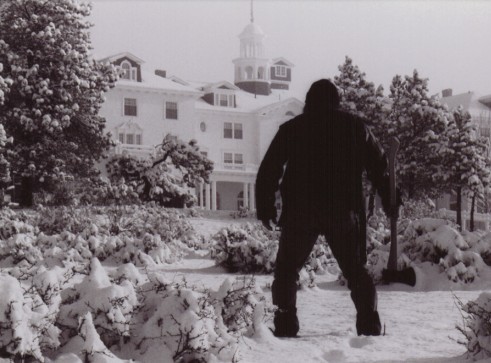 |
Once
in the shower, Sandusky began to tickle the boy and called
himself the "tickle monster".
After the tickling, he proceed to
lather up the boy's back and
shoulders.
Then he lifted
the boy in a chest-to-chest bear
hug and placed him under a
shower head to allow to spray to rinse out his hair. In the
process, Sandusky let his free hand drift inappropriately
over the boy's body.
When the boy returned home, his
mother noted the boy was acting differently.
In addition she could not understand why her son's hair was
wet. Upon questioning, the boy told her about the
shower.
Alarmed, the mother called a
psychologist about the incident,
as well as the University Police Department.
The Pennsylvania Department of Public Welfare
was called later in as well.
When the boy's mother confronted Sandusky on May 19, asking
if Sandusky had touched the boy's "private parts," he said,
"I don't think so ... maybe."
Unknown to
Sandusky, UPD Detective Ron Schreffler and a State College
police officer were listening from another room.
Sandusky asked if he could speak with the boy, but the
mother said no.
Sandusky hung his head and nodded.
"I understand. I was
wrong," Sandusky replied. "I wish I could get forgiveness. I
know I won't get it from you. I wish I were dead."
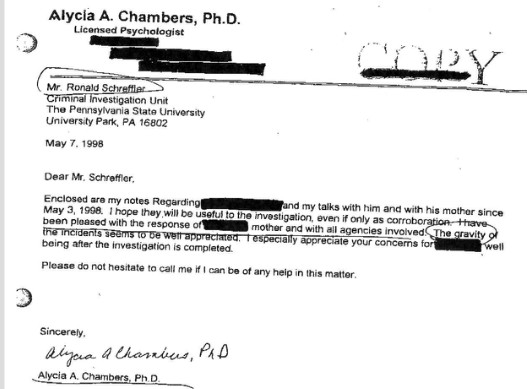 |
DR ALYCIA
CHAMBERS
The Huffington Post printed a remarkable
article about Dr. Alycia Chambers.
Back in 1998, UPD Detective Ron Schreffler
asked Dr. Chambers to interview the boy
about the incident and get her opinion.
Here are excerpts from Chambers' report:
"Sandusky had kissed
him on the head and said "I love you."
Then Sandusky promised the boy he could
come to his house and play on his "cool
computer" while sitting on his lap.
The young man
reported that Jerry played a game,
coming up behind him, saying he would
"squeeze his guts out" and hugging
him from
behind.
The boy wanted
his mother not to say anything because
Mr. Sandusky had promised to take him to
the movies and to let him sit on the
bench with him at Penn State football
games.
|
Chambers
not only reported the incident to the
Pennsylvania child abuse line,
she wrote a detailed report for the
Penn State police. In it, she concluded
that Sandusky's actions matched those of a "likely
pedophile".
"My consultants
agree that the incidents meet all of our
definitions, based on experience and
education, of a likely pedophile's
pattern of building trust and gradual
introduction of physical touch, within a
context of a "loving," "special"
relationship. One colleague who has
contact with the Second Mile confirms
that Mr. Sandusky is reasonably
intelligent and thus, could hardly have
failed to understand the way his
behavior would be interpreted, if known.
His position at the Second Mile and his
interest in abused boys would suggest
that he was likely to have had knowledge
with regard to child abuse and might
even recognize this behavior as typical
pedophile "overture."
After the Grand Jury released its report in
November 2011, Chambers was interviewed
by NBC News.
Chambers said
she was distraught when police contacted her
last year.
“I was
horrified to know that there were so
many other innocent boys who had their
hearts and minds confused, their bodies
violated,” she said. “It’s unspeakable.”
Chambers added that despite having a
trained
psychologist telling the
police IN WRITING that Sandusky fit
the profile of a pedophile, nothing was
done. He was not monitored. He was allowed
to continue to come into contact and work
with young children.
And now, he is
accused of sexually assaulting nine other
boys. Had her
report been given the attention it deserved,
these nine other boys would not have gone
through the ordeal they did. This abuse
could have been prevented.
What were the police thinking?
|
|
|
|
The 1998 incident was sent to Ray Gricar,
the district attorney. After long deliberation, the
district attorney decided not
to file charges. At that
point, the Penn State police chief instructed
that the case be closed.
To this day, no one is quite sure why
Gricar chose not to prosecute. At the time, Gricar
noted the evidence was right on the borderline of being.
It would be this little boy's word against the famous
football coach. On the other hand, Gricar had the
solid testimony of the hidden observers that Sandusky had
admitted touching the boy. He also had a signed letter from
the psychologist Alycia Chambers identifying Sandusky as a
"likely pedophile".
Why Gricar backed off remains one of
the unanswered mysteries of the Sandusky case. The conspiracy theorists suspect
someone at Penn State used their influence to get him to
back off, but there is no proof that this happened.
Unfortunately, Gricar is now "unavailable for
questioning".
As a
strange footnote
to this story, Ray Gricar
disappeared in 2005. His laptop and hard drive were
recovered from the Susquehanna River, irretrievably damaged,
and his body was never found. No one
knows if this
mysterious incident was related to the Sandusky cover-up,
but eyebrows were certainly raised.
However the
boy was still around. Now known as Victim 6,
he testified at Sandusky's trial in
June 2011 under the title . Now
age 25 at the trial, his testimony explains why so
much is known about what Sandusky actually did to
him.
|
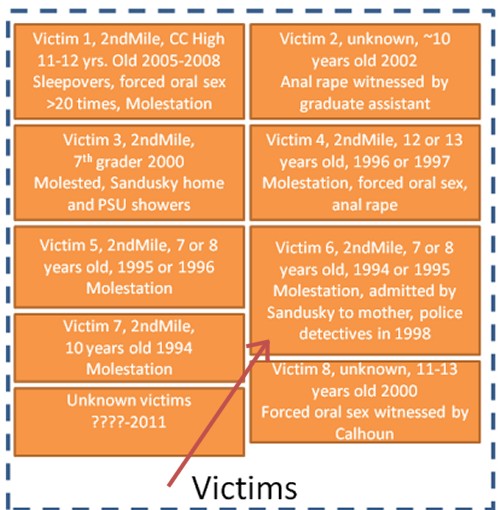 |
JOE
PATERNO 'KNEW' IN 1998 (and so did the rest of them)
The Freeh investigation criticized all
four men for their failure during the 1998
incident to stop Sandusky's abusive actions. The four
men were also criticized for their decision to conceal their
activities from the Penn State Board of Trustees.
In their testimony to the
Grand Jury, Spanier, Curley, Schultz and Paterno had all denied
knowledge of Sandusky's activities in the 1998 shower incident
investigation.
Schultz testified before the grand jury in January 2011.
He said he
could not recall that he “knew anything about the details of what
the allegation was from the mother.” He said he did not remember if
it was reported in the Lasch Building.
Curley denied that he was aware of the incident, though he said he
thought such an investigation would be brought to his attention.
Spanier said he had no specific knowledge.
Paterno testified that he was not aware of the incident, and
his family has steadfastly maintained that position through several
statements.
To the
contrary, the Freeh Report made one thing very clear
-
Spanier,
Curley, Schultz and Paterno were all aware of a 1998 investigation
into Sandusky’s conduct.
|
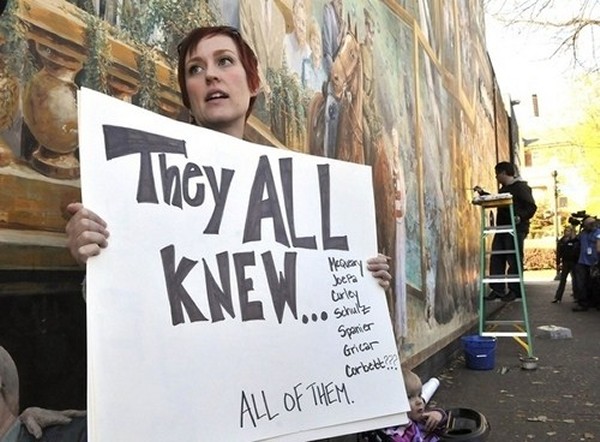 |
When the four men had been interviewed
by the Grand Jury, all four men had denied their
knowledge of Sandusky's activities.
For example, in his testimony
before the
Grand Jury investigating Jerry Sandusky, Joe
Paterno denied knowing anything about the 1998 incident in
which Sandusky was investigated. The
following exchange comes from a transcript of
Paterno's grand jury testimony.
Q: Other than
the incident that Mike McQueary reported to you, do you
[Paterno]
know in any way, through rumor, direct knowledge or any
other fashion, of any other inappropriate sexual conduct
by Jerry Sandusky with young boys?
A: Paterno: I do not
know of anything else that Jerry Sandusky would be
involved in, no. I do not know of it.
You did mention—I
think you said something about a rumor. It may have been
discussed in my presence, something else about somebody.
I don't know. I don't remember, and I could not honestly
say I heard a rumor.
The Grand Jury came across
enough contradictory evidence by the time it
was released in November 2011 to
file charges against Curley and Schultz for perjury.
However the same report
gave Paterno and Spanier room to maneuver. Both men
immediately began to claim AGAIN to the reporter's questions that they had no knowledge.
For example, in
Paterno's interview with Sally
Jenkins of the Washington Post shortly before his death
in January 2012,
Paterno said, "Nobody knew about it" when asked
point blank by Ms. Jenkins
about his knowledge of the 1998 case.
Thanks to Paterno's denials, there
were a lot of people who were willing to give the man the
benefit of the doubt. That makes sense. Paterno
had been the most respected man in Pennsylvania for a
lifetime.
This deception ended with the Freeh Report.
I don't think these men had any idea that emails from
thirteen years ago could be retrieved.
Uh oh.
Based on the emails, the Freeh Report said
Joe Paterno and
the three Penn State
officials were well aware of the investigation.
These four men
had numerous discussions in 1998 right
from the start until
the moment
district attorney Gricar decided not to press charges.
The release of the Freeh
report totally contradicted their previous Grand Jury testimony.
The Freeh investigators stated they had in their possession
a series of emails that the Grand Jury had not had access
to. These emails removed any possible
doubt that the four men were not involved in the cover-up.
THE FREEH REPORT FINDINGS REGARDING THE
1998 SHOWER INCIDENT
The incident involving
the boy in the shower, now referred to as "Victim
6", took place on May 3,
1998.
Word of the
assault reached Gary Schultz,
the university's vice president of business and finance,
on the following day (Note: I am unsure who phoned
Schultz, but it was likely the campus police).
VP Schultz was
notified that the boy had been interviewed again and had
provided additional details about the incident. Police had
also interviewed a second boy and he told a similar story,
according to the report.
As he listened on the phone, VP Schultz
wrote down some notes about Sandusky's
involvement.
-
“Behavior – at best
inappropriate, at worst
are sexual improprieties”
-
“At minimum
– Poor Judgment”
-
“Is this opening of
Pandora's box?”
-
“Other children?”
-
“Critical issue — contact
w genitals? Assuming same experience w the second boy? Not criminal.”
On May 5, the day following the phone
conversation with Schultz, the campus police seemed to back
away. According to Freeh’s findings, the records say that
the University Police determined on May 5 that they had found “no
evidence of a crime” and would not log the report. Campus police chief Thomas Harmon said they
would "hold off on making any crime log entry."
On
May 5, Gary Schultz
then turned around and notified
Spanier and Curley. Emails between Schultz and Curley imply
that they "touched base" with Joe Paterno about the incident
as well. From the Freeh Report:
On
May 5, Gary Schultz communicated with
Tim Curley, Penn
State's athletic director. Curley
checked with Paterno, then responded with this email back to
Schultz and PSU
president Graham Spanier at 5:24 p.m.
Captioned "Joe
Paterno", Curley
stated, "I
have touched base with the coach.
Keep us posted. Thanks."
(Note: when questioned about why his
name was listed on this email and why he had no recollection,
University President Spanier said in a written statement to investigators that it
was a “vague message with no individual named”, so he forgot about
it.)
As the
investigation progressed, Curley, the
athletic director, made several requests
to Vice President Schultz for updates.
Curley was probably put in the role of go-between by Joe
Paterno.
On May 13,
1998 at 2:21 p.m., Athletic Director Curley emailed Schultz a message
captioned "Jerry",
and asked, "Anything new in
this department? Coach is anxious to know where it
stands."
Anxious? You better believe
Paterno was anxious. Paterno was a control freak.
Once it became clear that Paterno "knew", it is difficult to
believe he didn't follow the proceedings every step of the
way.
Schultz
forwarded AD Curley's note to University police chief
Thomas Harmon, who provided an email update that
Schultz then forwarded to
Curley. The reference to
'Coach'
above is
assumed to be Paterno.
On May 18, 1998, AD Curley requested another update by
email. VP Schultz responded that there was no news and that
he did not expect to hear anything before the end of the
week.
On May 30, 1998, AD
Curley asked VP
Schultz for another update by
email.
VP
Schultz was on vacation at the time, but
responded that
investigators had told him they were about to meet with
Sandusky shortly. Schultz said that "DPW
and Univ Police services were planning to meet with him
[Sandusky]. I'll see if this happens and get back to you."
The investigator later informed
VP Schultz. He said, “I met with Jerry on Monday and concluded that there was no
criminal behavior and the matter was closed as an investigation. He
was a little emotional and expressed concern as to how this might
have adversely affected the child. I think the matter has been
appropriately investigated and I hope it is now behind us.”
On June 1, the
entire investigation was closed.
Sandusky was not
charged with a crime. The only admonition
Sandusky received from the
investigators was a warning not to shower
again with children. That was the
sum total of his punishment.
On June 9, Schultz informed Curley and Spanier of the
results via email. He told these men
that the investigation of the matter was
closed as such. Note that Spanier's
name was on the email. This makes it clear that
Spanier "knew" as well.
Paterno's name was not on the June 9th
email. No one is sure how Paterno found out the case
was closed.
After
Curley's initial updates to Paterno, the available
record is not clear as to how the
June 1 conclusion of the
Sandusky investigation was conveyed to Paterno.
However, witnesses
consistently told the Special Investigative Counsel that
Paterno was in control of the football facilities and
knew "everything that was going on."
In other words, there is great
likelihood that somebody verbally told Paterno the case was
over.
As Head
Coach, Paterno had the
authority to establish permissible uses of football
facilities. Nothing in the record indicates that Curley
or Schultz discussed whether Paterno should restrict or
terminate Sandusky's uses of the facilities of that
Paterno conveyed any such expectations to Sandusky.
Further events made it clear that Sandusky's access was in
no way curbed.
Not only did the
senior university officers turn a blind eye to the horror,
they allowed it to continue to happen.
Then years later they had the nerve to lie through their teeth when the story
finally emerged.
For example, 13 years later in
November 2011,
the very same Gary Schultz
claimed, "I was never aware
that 'Penn State police investigated inappropriate touching
in a shower' in 1998."
His convenient loss of memory would
come back to haunt Schultz. He is currently under
indictment for perjury to the Grand Jury.
In a strange footnote to this
incident, the Freeh Report later revealed that Penn State
attorney Wendell Courtney had billed the University a
whopping 2.9 hours for the incident involving Jerry
Sandusky’s locker room shower with a young boy. That
tidbit provides further circumstantial evidence that the
four men were clearly unaware of what was going on... they
were certainly aware enough to consult an attorney.
The four men were also worried about how to avoid letting the story go public.
They decided maybe it was best if the Board of Trustees
didn't hear about this. The campus police were
directed to put the file folder in a remote corner of a file
cabinet.
The Cover-up had begun.
|
|
|
|
|
JERRY'S
LAST STAND
There is no record that
Sandusky was ever disciplined or even spoken to by
Paterno or the "Three Stooges" as I will henceforth
refer to them. Please forgive my disrespect,
but men who are liars and men who fail to protect
children from deviates don't deserve respect.
The Freeh report said that
Penn State not only failed to protect children from
Sandusky by turning him in, they actually “empowered"
Sandusky to attract potential victims by allowing
him to have unrestricted and unsupervised access to
the University’s facilities and affiliation with the
University’s prominent football program.
After the May 1998 incident,
Sandusky would retain his position on Paterno's
staff for the next 18 months which included two
football seasons. This continued access provided
Sandusky with more lucrative opportunities to use
the Penn State program to lure his victims to the
premises.
A perfect example of how
Sandusky used the Penn State program to get more
victims took place
in San Antonio in December 1999.
Jerry Sandusky had
announced his retirement before the start of the
season. The Alamo Bowl
would be his final game.
|
The picture on the right shows
Sandusky being carried off the field by his players. Penn State
had just defeated Texas A&M 21-0 in the 1999
Alamo Bowl in San Antonio. To the world, this
crowning victory in the Alamo Bowl
made for a perfect ending for the coach's
32-year career.
Say what you will about
Sandusky the predator, but he was always a good
coach. The players credited Sandusky's
preparation and game plan for helping them pull off
the impressive shut-out.
His players thought Sandusky
was a hero for much more than his coaching ability.
They admired him because he dedicated most of his
off-season to running camps and helping The Second
Mile kids, many from single-parent homes.
These kids were desperately in need
of a strong male figure in their lives.
Sandusky's players admired him for his noble nature.
|
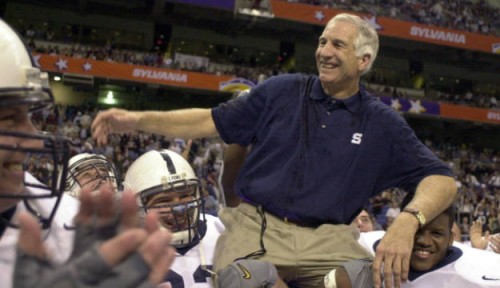 |
At the Alamo Bowl was one of Jerry's
boys. He was a Second Mile kid who had traveled with the coach to
the game. Sandusky had used the special trip as a way
to get permission from the boy's mother to bring the kid
along.
This kid would later tell investigators,
according to the grand jury report, that Sandusky sexually
abused him for about two years.
During the Alamo Bowl weekend, the boy said when he tried to resist
Sandusky's advances, the coach threatened to send him home.
That's when the boy realized how helpless he was. Thousands of miles away from home and
totally dependent on Sandusky, apparently at that point the
kid gave in.
When they returned home, the boy was
terrified of Sandusky. According to the Freeh Report,
the boy who had gone with Sandusky on that trip tried to distance
himself. Whenever the coach stopped by his house to visit,
he cowered in a closet and prayed no one would find him.
This story is just one example of many
that show many of Sandusky's victims did not desire sexual
contact with Sandusky. That mattered not to Sandusky.
He would use the Penn State name to lure the boys into
vulnerable situations, then force himself on them.
HIT
THE ROAD, JERRY
|
After the 1998 scandal was buried,
Jerry Sandusky stayed with Paterno for two more seasons.
Little can be found on the Internet to detail the exact
steps on the path that led to Paterno and Sandusky's parting of the ways.
However, a few educated guesses can likely fill in
the blanks.
There are few cultures in
America that are more homophobic than football
programs. That isn't to say there are no gay
athletes, but these men are usually very careful to
keep their preferences a secret. In a sport
that idealizes violence and manhood, there isn't
much room for acceptance when it comes to gay
players and gay coaches.
Although Paterno took his
secrets to the grave, I think it is safe to assume
that Paterno was "old school" when it came to his
attitudes on homosexuality. Once he discovered
the truth about Sandusky, it must have eaten at his
very core to know his fine young men were being
coached... and touched... by a sexual deviate.
It is hard to believe Sandusky lasted two more
seasons much less two more minutes under Paterno's
watch.
Seriously, given that Paterno
was a likely homophobe, it is difficult to
understand back in May 1998 why
Paterno didn't just send the man packing on the spot.
If Paterno had possessed the sense to do the right
thing, yes, the world would have been outraged that
this could happen at Penn State, but eventually
people would have praised Paterno for putting
integrity before expedience.
I cannot emphasize this point
enough. If Paterno had simply stuck to the
principles that had gotten him this far, today he
would be enshrined in the Pantheon of great sports
coaches right beside Vince Lombardi and Knute Rockne
till the end of time.
Why Paterno took the wrong
fork in the road remains the great unanswered
mystery. Why Penn State's attorney and top
administrators allowed Paterno to take that road is
almost as interesting a question.
|
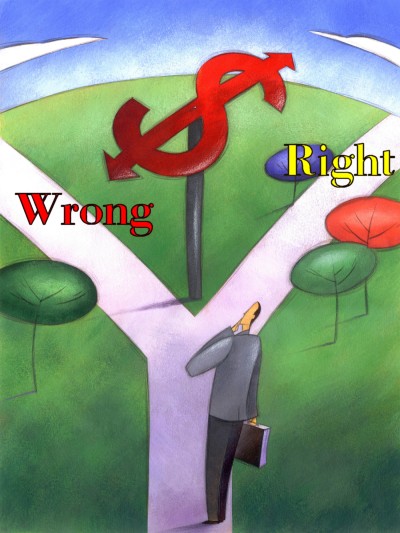 |
However, Sandusky was allowed to stay
on. Sandusky himself later confirmed that he and
Paterno never discussed the incident between them.
There are hints that the relationship deteriorated
steadily from this point on. A CNN story reported
ongoing friction between Paterno and Sandusky.
Ironically, one of the best insights came from one of
Sandusky's victims. According to the grand jury
report, one of the victims (#4) testified that Paterno summoned
Sandusky to his office in May 1999 and "told Sandusky he
would not be the next head coach at Penn State."
Sandusky told the victim "not to tell anyone," according to
the report. Two months later, the defensive coordinator told
reporters he was planning to hang it up at the end of the
season. The 1999 season would be his final year.
Rumors swirled of some kind of rift between Paterno and his
long-time assistant as the season progressed, according to
the Centre Daily Times, the main newspaper in State College.
Ahead of his final game, Sandusky was asked if he'd miss
Paterno.
"Not exactly," he said, according to a Sports Illustrated
article. "You have to understand that so much of our time
was spent under stress, figuring out how to win. That takes
a toll."
Whatever differences Paterno and his defensive coach might
have had, they didn't affect Sandusky's retirement package.
Sandusky retired with an
"unusual lump sum payment of $168,000".
He was given emeritus status. This entitled him to an
office in the team's practice facility and tickets to all
the games. Furthermore, as a retired coach, he retained
unlimited access to the football facilities.
Sandusky was also allowed to
keep his keys to the locker room which
would as we know allow him to continue to
prey on the boys he
claimed to be helping.
Once Sandusky was cut loose, Paterno
said he wouldn't miss him at all. Two years after
Sandusky's departure, Paterno hinted that Sandusky had been
a cancer. In January 2002, Paterno told the Centre Daily
Times, "In staff meetings, it was getting to be 'We' and
'You' and it should be 'Us.' Sandusky's leaving gave
me an opportunity to get that out of the way and do things
the way I'm comfortable with."
Maybe Paterno didn't miss Sandusky,
but his defense sure did. Paterno watchers point out
that the worst stretch of Paterno's career immediately
followed Sandusky's retirement. Paterno had five
losing seasons in a row. During the period from 2000 to
2004, Penn State had a losing record of 26-33.
Coincidence? Probably not.
Sandusky's loss was a huge blow for the program.
Sandusky was the leader of the
vaunted Penn State defense, the man most responsible
for creating "Linebacker U". When he left,
Sandusky had
just received the Assistant Coach of the Year award in 1999.
This was the second time he had won the award.
No one
understood why Sandusky left.
It was shocking to many that such a successful man
would leave at the peak of his career.
After all,
Sandusky was Paterno's right hand
man. He was supposed to be Paterno’s
heir apparent. Everyone asked, “Why is Jerry
Sandusky quitting? Heck, he’s
only
55. He's just getting
started! What’s Paterno going to do without this
guy?”
Reporters flocked to
Penn State to cover the story. Sandusky
explained his strange decision to Sports Illustrated
by saying he wanted to devote more time to his
charitable foundation while he was
still young and
vigorous. Sports Illustrated and all the other
writers bought the story hook line and sinker. What
a wonderful man!!
|
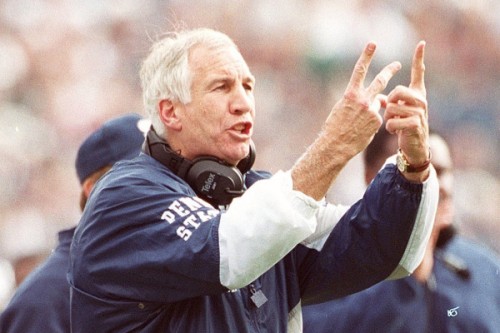 |
SPORTS
ILLUSTRATED STORY By Jack McCallum
Rick
Archer's Note: I was curious to know if the man
who wrote the original SI story on Sandusky's
strange retirement had anything to say about it
after the Grand Jury indictment.
I found that the reporter, Jack McCallum, did indeed
have something to say about the matter.
VIEWPOINT
Written by Jack
McCallum
Posted: Tuesday November 8, 2011 12:44PM
Jerry
Sandusky fooled a lot people over
the years -- including me
Sometimes when you get
fooled in this business, it's not so bad. You
write that, say, the Patriots are unbeatable and
then they get beat that week. Or you write that
Kobe is in a severe shooting slump and he lays
58 on somebody the next night. A couple hundred
people write you to ask, "Why do you even have a
job?" and you smile and life goes on.
But other times? Other times you feel real bad
when you get fooled.
I didn't even realize my small part in this
foul, almost unimaginable debacle at Penn State
until a friend emailed me after the sexual abuse
revelations about former defensive coordinator
Jerry Sandusky came to light.
"I guess you feel like a jerk," he said,
reminding me of a 1999 feature I wrote about
Sandusky and his Second Mile organization.
Then I remembered.
The genesis of the story has a subplot, as so
many stories do. I had originally gone to State
College to write about a 9-0 Penn State team
that was challenging for the national title. I
show up, and the Nittany Lions lose 24-23 to a
not-very-good Minnesota team, scrapping a Penn
State story.
"Well, you know, the defensive coordinator,
Jerry Sandusky, is retiring so maybe I could get
a feature out of that," I told my bosses. "He
runs this organization called Second Mile to
give at-risk kids a second chance so ..."
It sounded like a winner. So I did it, and it
appeared in the Dec. 20, 1999 issue of SI. I
recall getting a few
thanks-for-recognizing-Jerry letters from Penn
State stalwarts, of which there are thousands
and thousands, many of them in the area of
Pennsylvania where I live.
I have combed through my remaining brain cells
to conjure up memories about that story and
can't come up with much. I met Sandusky and his
wife. The story wasn't long. It was written in a
hurry and has a mailed-it-in feel to it. It
wasn't very good.
More to the point and most obviously, I had no
suspicions about anything untoward going on with
Sandusky or Second Mile. I remember that I
didn't particularly like the man -- he seemed a
little strange and detached and not at all
joyful about what he was doing -- but none of
that tipped my cynical
believe-the-worst-about-anyone-until-proven-otherwise
journalistic dial toward high alert.
SI senior writer Phil Taylor, who wrote a column
about Sandusky in the this week's magazine,
called me and said, "Hey,
Jack, I found it unusual that you didn't
have anything in your piece
from the other coaches, nothing from Paterno
about how wonderful this guy is or anything like
that."
"I wish I could tell you why, Phil, but I
can't," I told him. "Maybe I was in a rush.
Maybe it got cut out for space. Maybe their
quotes weren't any good. Maybe I never got back
to JoePa. I had already talked to him about the
main story that fell apart so..."
No answers. No nothing.
What I do remember about the experience was the
world-unto-itself isolation of the Penn State
football complex. I did a couple early-morning
interviews over there (not with Sandusky) and we
might as well have been on the moon. It was the
perfect place for a predator like Sandusky, and
it's like that on most high-profile,
football-driven campuses. But I'm only thinking
about the consequences of that now.
Two things in particular haunt me. By the time I
wrote the story, Sandusky's showering with a
youngster had already triggered a campus
investigation, albeit one that never
became public.
And the revelations in
the "Jerry Sandusky Grand Jury Report" -- I
recommend that to those of you who feel that
Sandusky and Penn State officials are being
railroaded fire up Mr. Google and read it --
reveal that some of Sandusky's worst behavior
was going on right around this time. So I wrote
a favorable story about a guy who was already a
sexual predator.
The other thing haunting me is my last line in
the story: "Here's the best thing you can say
about Jerry Sandusky: He's the main reason that
Penn State is Linebacker U ... and linebackers
aren't even his enduring legacy."
Writers love to have their stuff quoted ...
unless the quotes make you look like a jerk, as
these do. So go ahead, Deadspin, have at it.
What leaves me shaking my head is how badly I
feel about this unfortunate story and how
inconceivable it is that Joe Paterno, a man I
always respected, asks us to believe that he has
no culpability. He has already yakked himself
into a corner.
Maybe he didn't know everything that was going
on. But he knew enough. He wasn't fooled. And
that's why his silence is unforgivable."
Rick Archer's Note:
"albeit
one that never became public."
If you
notice, McCallum spent a week on the Penn State
campus writing the original article and not once did
he ever come across the 1998 report about the shower
incident and the campus investigation.
That
indicates just how well the cover-up was working at
the time.
|
|
| |
|
THE 2000 INCIDENT
Thanks to "Strike One", Sandusky
was no longer a coach. But
Sandusky still had full access to
the university recreational
facilities. Sandusky would
continue to assault children over the next two years on Penn
State's campus and at a team hotel.
Strike Two took place in the Fall of 2000. A janitor named James
Calhoun observed Sandusky in the showers of the Lasch
Football Building with a young boy (Victim 8)
estimated to be 11. The identity
of this poor child has never been confirmed.
Sandusky pinned the
boy up against the wall and performed oral sex on the boy.
Calhoun was
so shaken, he went to tell the other janitorial staff
immediately. Another janitor, Ronald Petrosky, went to
clean the showers at Lasch. He confirmed Sandusky was still
with the boy. However Petrosky could see they were
done now.
Calhoun
told
other physical plant employees what he saw, including Jay Witherite, his immediate supervisor. Witherite
told Calhoun to whom he should report the incident.
Calhoun did not make that report.
Petrosky did not make a
report. Witherite did not make a report
either. Like everyone else
in this ongoing tragedy, they were afraid to stick
their necks out.
|
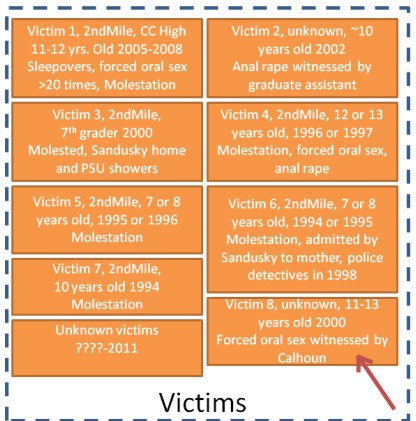 |
According to the
Freeh report, the janitors did not report the incident out of
fear that they would lose their
much-needed jobs. Freeh
noted their reluctance showed how afraid they were of
"taking on the football program."
Amazingly,
Sandusky had been caught in the act
at Penn State for the second time. He was allowed to continue
because these men
decided to look the other way.
|
| |
|
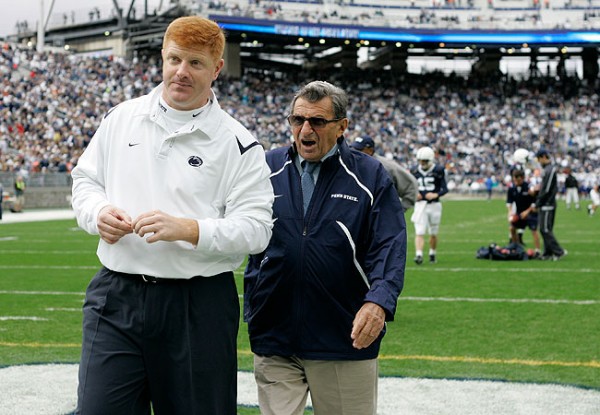 |
THE 2001 INCIDENT
The event that would eventually shake
Penn State to its foundations took place on February
9, 2001. A Penn State graduate assistant named Mike McQueary entered the locker room at the Lasch Football
Building late at night.
He heard a voice
in the darkened room. Suspicious, McQueary peeked around
the corner In the showers. There he saw a 10 year old naked
boy (Victim 2) being subjected to anal intercourse by a
naked Sandusky.
McQueary was
stunned. He was so paralyzed with shock that he did
nothing. McQueary left immediately and told his father what
he had witnessed. His father said go tell Joe Paterno.
The very next
morning, McQueary called Paterno and received permission to
go to Paterno's home. There in Paterno’s living room,
McQueary reported what he had seen.
According to the Freeh report, Paterno told McQueary,
"You did what you had to do. It's my job now to figure out
what we want to do."
|
That should have
been the end of it right there. This was
Strike Three for Sandusky.
Why wait any longer? They
gave Sandusky a second chance in 1998. This
2001 incident should
have been all the proof needed to Paterno
and the Stooges that Sandusky was too sick to control himself. Just do the right thing.
Turn him in.
Paterno should have called the campus
police on the spot and had Sandusky arrested. Something had
to be done or other children would suffer the same fate. However,
that is not what Paterno did. Paterno told McQueary
to keep it to himself and let him
handle things. After that, Paterno thought
about it for a day.
The following
morning, Paterno called Tim Curley, the Athletic
Director, and asked him to come to his home. Paterno
reported a version of what the graduate assistant had said.
From
there Curley quietly began a new round of
discussions with various
administration people on what to do.
Later in the
month McQueary was called to a meeting with Curley and
Senior Vice President for Finance and Business Gary Schultz.
The graduate assistant reported again what he had seen.
The meeting concluded with Curley and Schultz saying they
would look into it.
Spanier,
Curley, Schultz and Paterno then spent
more time debating what they would do and whether to
report Sandusky to authorities. During this same
period, Curley said he met with executive director
of the Second Mile and "shared the information we
had with him."
The
Second Mile leadership concluded the matter was a
"non-incident."
|
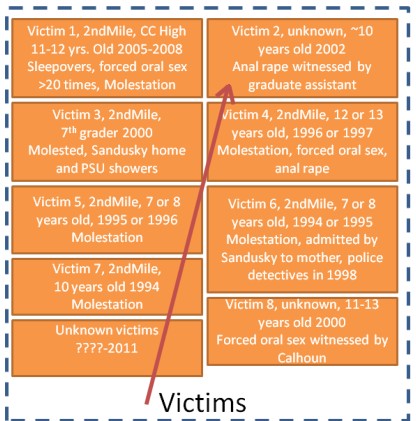
Rick's Note: in an attempt to be
accurate, it was
later determined the attack once labeled "2002"
actually occurred on Feb. 9, 2001 |
Eventually, they
decided not to report Sandusky at the insistence of Paterno.
Some time later McQueary heard from Curley. He was told that Sandusky's
locker room keys had been taken away and that the incident
had been reported to The Second Mile, Sandusky’s charitable
foundation.
McQueary was
never questioned by university police. McQueary
never heard another word about it until
nine years later when
out of the blue McQueary was summoned to
testify before the Grand Jury in December 2010.
When the Grand Jury released its
report in November 2011, people were riveted by
McQueary’s
dramatic
Grand Jury testimony
regarding what he had seen in the shower
run in 2001. The media was in a feeding frenzy.
Every person at Penn State was being asked to comment on who
knew what and when. For a few days there, updates and
new stories broke on an hourly
basis.
To the young man's surprise, McQueary
suddenly discovered the cover-up was all his fault. He
was now the scapegoat.
As the media swarmed Happy Valley,
Curley, Schultz, and Spanier all pointed the finger at McQueary.
Yes, McQueary had said something to them, but it was so vague that
none of them had grasped the true seriousness of the
situation. McQueary had led them to believe that
Sandusky's actions had merely made the boy 'uncomfortable'.
Had
McQueary
simply told them EXACTLY what had happened, of course they
would have taken the incident more seriously.
Fortunately, soon enough the truth came
out. The state
attorney general turned the table on
these self-serving liars just days later. He
reported he was now in possession of emails
shared between some of
the men McQueary told about the incident: Penn State's
president Graham Spanier, vice president Gary Schultz and
athletic director Tim Curley, the Three
Stooges.
Those emails not
only showed that McQueary was quite
clear in his reporting of the incident but that these
three officials had made the potentially criminal
decision to not turn the information over to social services
or law enforcement. Schultz and Curley
would definitely be charged with perjury and Spanier was
still under investigation.
President Spanier was now in a lot of
trouble.
Shortly after his
November 2011 dismissal, Spanier issued a
statement that said, "I was stunned and outraged to learn
that any predatory act might have occurred in a university
facility or by someone associated with the university. ... I
would never hesitate to report a crime if I had any
suspicion that one had been committed."
Spanier said this before he was aware
that the Board of Trustees would throw a curveball at him.
When the Board hired Louis Freeh, they gave him power
to review all emails.
Freeh's team uncovered an exchange of
messages from February 26 to February 28, 2001,
where Spanier
allegedly acknowledged Penn State could be "vulnerable" for
not reporting the 2001 incident.
"The only downside for us is if the
message (to Sandusky) isn't 'heard' and acted upon, and we
then become vulnerable for not having reported it."
A story on the
CNN Website does a good job of explaining this
series of emails and decisions.
In an
exchange of messages from February 26 to February 28,
2001, Spanier allegedly acknowledges Penn State could be
"vulnerable" for not reporting the incident,
according to two sources with knowledge of the case.
"The only downside for us is if the message (to
Sandusky) isn't 'heard' and acted upon, and we then
become vulnerable for not having reported it," Spanier
purportedly writes.
The alleged e-mails among Spanier, Schultz, 62, and
former Athletic Director Tim Curley, 57, never mention
Sandusky by name, instead referring to him as "the
subject" and "the person." Children that Sandusky
brought on campus --some of whom might have been victims
-- are referred to as "guests."
The purported exchanges began 16 days after graduate
assistant Mike McQueary first told Head Coach Joe
Paterno on February 9, 2001, that McQueary believed he
saw Sandusky make sexual contact with a boy in a locker
room shower.
Since the scandal broke, Schultz and Curley have
publicly maintained McQueary reported only inappropriate
conduct -- horsing around. The purported e-mails
indicate the men could be at additional risk for not
disclosing the matter to authorities. Schultz and Curley
are currently charged with perjury for allegedly lying
to a grand jury and failing to report suspected child
abuse. They have pleaded not guilty.
Paterno testified before a grand jury that McQueary was
"very upset" and said he saw Sandusky "doing something
with a youngster. It was a sexual nature," according to
a transcript. Paterno testified he told his boss,
Curley. Curley and Schultz contacted McQueary about a
week and half later about the incident.
In an alleged e-mail dated February 26, 2001, Schultz
writes to Curley that he assumes Curley's "got the ball"
about a three-part plan to "talk with the subject
[Sandusky] asap regarding the
future appropriate use of the University facility," ...
"contacting the chair of the charitable organization"
and "contacting the Department of Welfare," according to
a source with knowledge of the case.
(The "subject" is Sandusky and his Second Mile charity
is the "charitable organization," according to a source
with knowledge of the e-mails. Pennsylvania law requires
suspected child abuse be reported to outside
authorities, including the state's child welfare
agencies).
The next evening, February 27, Curley allegedly writes
to Spanier; Schultz, who's out of the office for two
weeks, is copied.
Curley refers to a meeting scheduled that day with
Spanier and indicates they apparently discussed the
Sandusky incident two days earlier.
Curley indicates he no longer wants to contact child
welfare authorities just yet. He refers to a
conversation the day before with Paterno. It's not known
what Paterno may have said to Curley.
Curley allegedly writes: "After giving it more thought
and talking it over with Joe yesterday, I am
uncomfortable with what we agreed were the next steps."
The athletic director apparently preferred to keep the
situation an internal affair and talk things over with
Sandusky instead of notifying the state's child welfare
agency.
"I am having trouble with going to everyone, but the
person involved," Curley allegedly continues.
Curley writes he'd be "more comfortable" meeting with
Sandusky himself and telling him they know about the
2001 incident and, according to a source with knowledge
of the case, he refers to another shower incident with a
boy in 1998 that was investigated by police but never
resulted in charges against Sandusky.
Curley purportedly writes to Spanier, saying he wants to
meet with Sandusky, tell him there's "a problem," and
that "we want to assist the individual to get
professional help."
In the same purported e-mail provided to CNN, Curley
goes on to suggest that if Sandusky "is cooperative,"
Penn State "would work with him" to tell Second Mile. If
not, Curley states, the university will inform both
Second Mile and outside authorities.
Curley adds that he intends to inform Sandusky that his
"guests" won't be allowed to use Penn State facilities
anymore.
"What do you think of this approach?" Curley allegedly
writes to Spanier.
About two hours later, the Penn State president responds
to Curley in another e-mail and copies Schultz.
Spanier allegedly calls the plan "acceptable," but
worries whether it's the right thing to do,
according to two sources.
"The only downside for us is if the message (to
Sandusky) isn't 'heard' and acted upon, and we then
become vulnerable for not having reported it,"
Spanier purportedly writes.
"But that can be assessed down the road. The approach
you outline is humane and a reasonable way to proceed,"
he adds.
The next afternoon, Schultz allegedly responds to the
Penn State president and its athletic director. Schultz
signs off on handling the matter without telling anyone
on the outside, at least for the time being.
"This is a more humane and upfront way to handle this,'
Schultz purportedly writes. But he makes clear Penn
State should inform Sandusky's charity Second Mile "with
or without (Sandusky's) cooperation."
As for telling child welfare authorities, he adds, "we
can play it by ear."
This cold-blooded assessment on
Spanier's part makes it
clear that Big Four were well aware they were engaged in a
criminal cover-up.
Well, Spanier was right. Once
Freeh exposed them, all three administrators were vulnerable
all right.
The Penn State University was
definitely "vulnerable". Legal experts say the Freeh
Report laid the University open to untold number of
lawsuits. Exactly how many proven or alleged victims might
come forward to try to dip into Penn State’s $1.8 billion
endowment is not known. A total of 10 known Sandusky
victims were mentioned during trial, though two were never
identified by name. Some of them may ultimately decide to
enter into private negotiations with whatever entity Penn
State creates to tackle the compensation problem. Others may
decide to file civil suits. In addition, papers filed with
the court make it clear prosecutors also had “victims Nos.
11 through19” standing by in case of acquittal or a possible
federal case.
The Three Stooges are quite likely
"vulnerable" as well. When Spanier referred to doing
the "right thing", it turned out he wasn't referring the
MORAL right thing, but rather the safest legal course to
take.
In the end, once the Freeh Report
pointed the finger of truth at them,
the Three Stooges scrambled to change their story.
Suddenly they all started to remember that yes, maybe they
did know a little back then.
Now these men defended their actions
not to report Sandusky to the police as an effort to
be "humane" to Sandusky.
This new version didn't win the Stooges much sympathy.
Let's think about the monster's feelings!! How comforting
it must be for
everyone to know that a sexual monster received more
consideration than the poor little boys who had been raped.
Furthermore, the
emails revealed the loathsome secret that these three men
as well as Paterno had known all along they were
harboring a sexual predator in their midst.
These four men had conspired to let
Sandusky walk free on a felony sex crime.
Meanwhile, the world got to see what
happens to whistleblowers. The Three Stooges had
attempted to shift the blame to McQueary.
Thanks to statements from the Three Stooges
saying it was his fault for one reason or the other, McQueary's
time at Penn State was over.
McQueary had unknowingly dealt with a
bankrupt culture he should have
never trusted. As a result of their
lies, McQueary was subjected to extreme public
humiliation after the Penn State
administrators managed to shift the blame to him for not
accurately reporting what he had seen.
McQueary had “misled” them.
The emails
changed all that. McQueary had told the truth right from
the start. Nevertheless he was
publicly humiliated across the land for not doing enough.
Articles such as "McQueary Guilty of Not Doing Enough"
appeared across the Internet. For heaven's sake, this
young man is only person who actually did the right thing.
However, the
damage was done. Due to his unusual name, McQueary's
reputation was likely tainted for the rest of his life.
Once the truth came out, now people
began to ask the correct question - why didn't Paterno do
more?
One of the burning issues was how
McQueary had described the alleged assault to Paterno.
After witnessing the alleged assault and consulting his
father, the first person McQueary notified was Paterno.
Paterno was quoted as saying "[McQueary]
at no time related to me the very specific actions contained
in the Grand Jury report."
However, this begs the question of
just what McQueary conveyed, especially given the fact that
the grand jury report alleges McQueary included the graphic
details when he met with Curley and Penn State vice
president Gary Schultz.
In addition, we now know Paterno was
aware of Sandusky's proclivities based on the 1998 incident.
No matter how McQueary described seeing "anal sex", one
would assume Paterno was smart enough to put two and two
together.
At this point, Paterno's children
took up the defense of their father's total lack of action in this crucial
incident.
Scott Paterno, son of the former head
football coach, told CNN contributor Sara Ganim that "we wish
our father (Joe Paterno) been
more aggressive in following up."
"But clearly my father thought it had been handled," he said,
referring to the 2001 report of Sandusky's abuse of a minor.
"There wasn't anything more Joe Paterno could have done
because it was an unsubstantiated allegation," the younger
Paterno continued. "I know my father did not know Jerry was a
pedophile and did not suspect he was a pedophile."
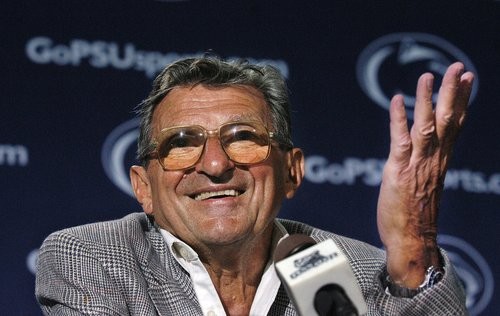 |
What a totally predictable response from a loyal son.
However, it is absolute nonsense. Can't anybody take
responsibility? Does everyone involved in this story
have to run from accountability?
The fact is that at least four people
screwed up badly. Sandusky should have been stopped in
2001. Instead, the
2001 incident was swept under the
carpet just like the 1998 incident. Sandusky was free to
attack more little boys. He operated with impunity right
under the noses of the head coach, the president, the vice
president, and the athletic director.
With the cover-up still
intact, Paterno’s march
to immortality continued untouched by the
time-bomb scandal hidden within his program.
In May
2006 Paterno was elected to the College Football Hall of
Fame. He was now up to 363 career victories.
Meanwhile the time bomb was ticking.
|
|
|
THE LITTLE HOUSE OF HORROR
Once Sandusky got his victims into the
basement of his house, they were absolutely helpless.
At the trial of Jerry Sandusky,
without a doubt, the most heart-rending story of all came
from Victim 9, a boy who was raped repeatedly in the
mid-2000s during
sleepovers at Sandusky's house.
This is strong stuff, but there's no
point in soft-soaping any of this. When I describe Sandusky
as a "monster", there is no better way to make this clear
than to share the story of this little kid that emerged from
Sandusky's trial.
|
 |
Victim 9
Story written
by COLLEEN CURRY and BETH LOYD for
ABC NEWS
BELLEFONTE, Pa. June 14, 2012
The courtroom was once again
brought to tears today as the 18-year-old known as
Victim 9 said that for four years Sandusky would come
downstairs to the basement, drop his pants, and rape him
and force him to perform oral sex.
"He started getting physical, like having me touch his
penis and stuff," he said. "He made me give him a, suck
his penis is how you'd put it. He came in my room,
pulled his pants down, laid on top of me, and kind of
forced it in. What was I going to do? I
mean look at him, he's a big guy. He was bigger than me,
at the time way bigger than me."
Victim 9 said he weighed less
than 70 pounds at the time and was helpless when
Sandusky allegedly came for him.
"There was no fighting against it," he said. "Sometimes
(I'd) scream, sometimes tell him to get off me, but
other than that, who was there? We were in the basement,
no one could hear you down there. We were always down
there."
When asked to point out his alleged assailant, Victim 9
pointed as Sandusky without looking at him.
"Can you look at him?" the prosecutor asked. "I don't
want to look at him," the witness replied.
Victim 9 was the eighth and final alleged victim to
testify about being molested in the case against
Sandusky, who is charged with 52 counts of child sex
abuse. If convicted of the charges, Sandusky, 68, could
be sentenced to life in prison.
The man said that his abuse by Sandusky lasted until he
was about 16, in the year 2009. The timeframe suggests
that Sandusky may have continued to abuse boys while
under investigation by a grand jury, since the
investigation was launched in late 2008.
Victim 9 said his mother encouraged him to spend time
with the coach and that he spent almost every weekend at
Sandusky's house for three years, between 100 and 150
times, and the acts occurred "often."
The man said that around age 16 he refused to go over to
Sandusky's house any more, but Sandusky called him once
more in 2011 to ask him to "stick up for him" if anyone
came to ask questions, he testified.
Upon cross-examination, the man admitted that he went on
one more outing with Sandusky shortly before the coach's
arrest to a football game in September 2011. He said
that he wanted to take his friend, who had never been to
a football game, to the Penn State stadium.
"The only reason I went that time was I had a friend
with me, and my friend didn't like him anyway. If
anything went down, my friend had my back," he said.
The cross-examination was also graphic as defense
attorney Joseph Amendola asked the boy repeatedly
whether he bled from the anal rape and whether his
mother saw blood on his underwear. He calmly responded
that he had bled, but his mother did not discover it on
his underwear.
"I just dealt with it. I never told anybody, I didn't
even tell my own mom," he said. "I just deal with things
in my own way."
Victim 9 said he never told his mother or anyone until
he spoke to police, and he only told prosecutor Joseph
McGettigan the whole truth shortly
before his testimony today.
"How are you supposed to tell your mom something like
that?" he said. "Who would believe you?
He was an important guy,
a football coach. Who would believe kids?"
Rick's Note:
This story was so horrible it reminded me of the
legend of the Minotaur of Crete
The wife
of King Minos gave birth to Minotaur, a creature
that was half man and half bull. King Minos was
disgusted by the monster, but did not want to kill
it. So he hid the monster in the dark
Labyrinth deep below the castle.
The
monster had to be fed. Minos imprisoned young
children in the Labyrinth so that the Minotaur could
eat them. The labyrinth was such a complicated maze
that no one could ever find the way out alive.
The
children would wander totally alone in the darkness
crying and full of fear. Eventually the monster
would find them. As they died with a scream
upon their lips. No one ever came to their rescue.
When I
think of Sandusky, I think of the Minotaur.
As
another strange footnote to this story, Sandusky's lawyer
Joseph Amendola had absolutely no shame. He repeatedly accused many of the witnesses of lying.
How can anyone read that
poor child's story above and imagine that kid
was lying? It just boggles the mind.
|
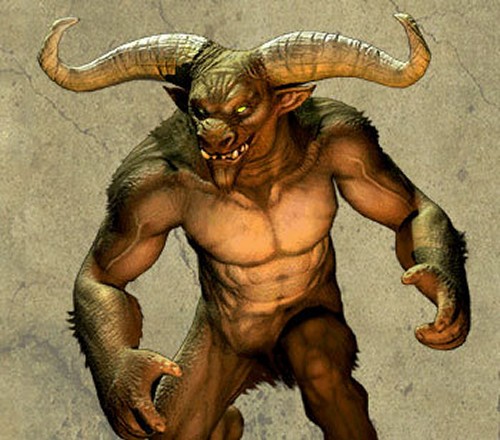 |
Amendola would tell anyone who would listen
that Sandusky was completely innocent.
For example,
minutes after
Sandusky was convicted, he was led out of the
Pennsylvania courthouse in handcuffs. Walking beside
him was his lawyer. Amendola stopped in front of the
cameras to tell the world he believed his client was innocent and that
he intended to appeal the conviction. Poor Jerry
Sandusky! He was the real victim here.
Amendola even had the nerve to go on national TV and say the
same thing. In an interview with Bob Costas, Amendola said
he was totally convinced of his client’s innocence.
Then Amendola said he wouldn’t have taken the case were he not
convinced of Sandusky’s innocence.
For good measure, Amendola added that he would “absolutely”
let his own children spend time alone with the former
football coach.
Although it is difficult to conceive there might be humor in any
remote corner
of this ongoing tragedy, this did provoke a funny note.
Shortly after the Costas interview, Amendola’s estranged
wife wrote on her Facebook page,
“OMG. Did
Joe just say he would allow my kids to be alone with
Jerry Sandusky?”
Maybe the myth
of the Minotaur is no myth. The comparisons to
Sandusky are inescapable.
|
2008 - THE BOY WHO BROKE IT OPEN
|
(more
detailed story in USA Today)
|
Someday the full story will come out
about the young man who finally took Sandusky down.
Known as "Victim 1", this boy is a hero. He is 17 and
recently graduated from high school. What we do know
of his story is nothing short of remarkable.
This young man was forced to deal with
intense fear and constant shame for the past six years.
Not only was he absolutely convinced Sandusky would hurt him
or even kill him for turning him in, the boy was subjected
to years of bullying and humiliating taunts by his
classmates.
Sandusky met
this young man in 2005 when he was a 10 year-old kid.
Like all the others, Victim 1 had the misfortune of
participating in Sandusky's Second Mile camp.
Like all the others, this kid had no
father and was in great need of attention.
Sandusky
took a shine to him. He began to
meet the young man at his school and drive him home.
This escalated into
invitations to sleepovers at Sandusky's house.
Records show that
the young man stayed overnight at Sandusky’s residence in
College Township, Pa, on many occasions.
Yes, he too fell victim to the Little House of Horrors.
|
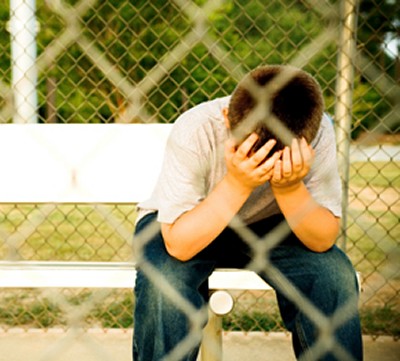 |
One has to wonder if Sandusky’s
wife ever noticed anything. If
so, did she too look the other way? As the reader can
gather, heroes in the Sandusky-Paterno saga are few and far
between.
In 2007 the kid
became a high school freshman. This
was the moment he tried to
pull away. He was 15.
Sandusky noticed the
growing distance.
He did everything in his power to maintain the tie.
Victim 1 said he was taken to football practices in 2007, a
direct violation of Penn State's 2001 stipulation that
Sandusky not bring children on campus. Sandusky was
obviously still using Penn State football as bait.
Sandusky asked to
become a volunteer football coach at the school, more than likely to
give him reasons to be near the boy.
This would prove Sandusky's undoing. In 2008, Sandusky
was finally busted. Not surprisingly, this story is just as
pathetic as all the rest.
One day after
school in late 2008, Victim 1 told his mom he was afraid his
teachers thought he was a bad kid.
“Why
is that?” his mother asked.
He told her
Assistant Principal Steve Turchetta — who
was also the head football
coach and the athletic director — called him down to the
“principal’s office” a lot so that Sandusky could talk to
him privately. Sandusky would then plead with the boy to
come back to his house for renewed
sleepovers.
His mother was
furious. She had never given
permission for her son to be removed from class. She called
the school the next morning to complain.
After listening, Principal Karen Probst
was sufficiently concerned to get to the bottom of
it. She had the young man called into her office. Alone,
the two of them had a conversation. She started asking him
questions about Sandusky. The teenager became quickly
overwhelmed and had a breakdown.
He explained to
Probst that Sandusky was abusing him. The boy was not brave
enough to reveal all the details, but he said enough to
alarm the principal. The cat was
out of the bag.
His mother was
called, so she came to pick up her
son. Together they
immediately went to the Clinton County Children and Youth
Services offices. A report was taken and Sandusky was
listed as an “indicated” child abuser within a few hours.
The mother has
said Probst urged her to "think about" the gravity of such
allegations before reporting them. But the school has
denied this. They said they immediately reported what the
teen told Probst.
Either way, the
Keystone Central School Board was notified, and Sandusky was
banned from campus. His absence was soon noted. The parents
of the football players didn’t understand why they were
losing their celebrity volunteer coach. Somehow the
constant look of misery on Victim 1’s face aroused suspicion
among the players. They knew Sandusky was always
hanging around this boy.
Victim 1’s mother
said she found out there was a meeting of football parents.
It’s unclear what was said in that meeting. But soon after,
Victim 1 and his mom started getting questions from
students, parents, friends and acquaintances in the
community.
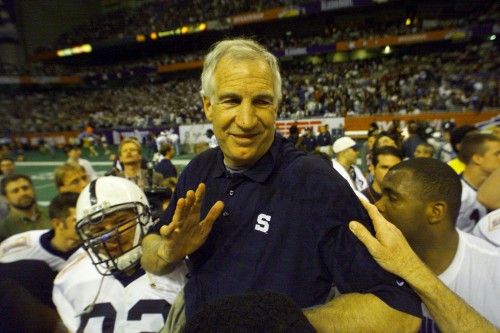 |
Things like, “We
heard it’s your son who accused Sandusky,” and “You guys are
just looking for money,” and “We know Sandusky will be back
to coaching soon.”
One woman
confronted Victim 1’s mom in the Goodwill store, the mom
said. “She told me ... no charges will ever be filed, and
Sandusky will be back to coaching
before long,” Victim 1’s mother
said.
At this point, several classmates
began to bully Victim 1. According to the young man's
psychologist, apparently, his fellow classmates at Central
Mountain High School didn’t like that he told people about
being sexually assaulted by the popular coach. They
taunted him endlessly about his role in the sexual affair.
Much of what they said was very ugly.
Eventually as time passed, the
harassment died down. Sandusky was being investigated,
but the wheels of justice moved slowly. It would take
three years for the State to build its case against
Sandusky.
|
|
| |
|
Paterno
Prepares for
the Coming Storm
|
On November 6,
2010, Penn State defeated Northwestern, 35-21.
Paterno
had just earned career victory No. 400.
Joe Paterno
was the first Division I
coach to ever reach that mark. It
was cause for great celebration on the Penn State
campus.
However, two short months
later, an ominous dark cloud rolled over the Penn
State community. In January 2011, Joe Paterno
was called to testify before the Sandusky Grand Jury
while it was still in the process of building its
case.
This is
when Paterno first realized prosecutors were
investigating his longtime assistant coach Jerry
Sandusky.
Apparently this let the cat out of the bag. Soon
after Paterno had testified before a grand jury, the
rough outlines of what would become the giant
scandal were first published in a local newspaper.
|
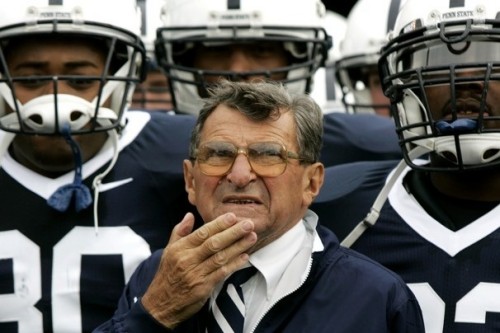 |
With a
flood of trouble impending, Paterno immediately
began scrambling for high ground.
It took
over a year for the details to come out, but a July
2012 story published in the New York Times by Jo
Becker revealed Paterno took steps to ensure his
personal fortune at the exact same time he
discovered how much trouble Sandusky was in.
Read for yourself.
That
same month (January 2011), Mr. Paterno, the
football coach at Penn State, began negotiating
with his superiors to amend his contract, with
the timing something of a surprise because the
contract was not set to expire until the end of
the 2011 season, according to university
documents and people with knowledge of the
discussions. By August, Mr. Paterno and the
university’s president, both of whom were by
then embroiled in the Sandusky investigation,
had reached an agreement.
Mr. Paterno was to be paid $3 million at the end
of the 2011 season if he agreed it would be his
last. Interest-free loans totaling $350,000 that
the university had made to Mr. Paterno over the
years would be forgiven as part of the
retirement package. He would also have the use
of the university’s private plane and a luxury
box at Beaver Stadium for him and his family to
use over the next 25 years.
The university’s full board of trustees was kept
in the dark about the arrangement until
November, when Mr. Sandusky was arrested and the
contract arrangements, along with so much else
at Penn State, were upended. Mr. Paterno was
fired, two of the university’s top officials
were indicted in connection with the scandal,
and the trustees, who held Mr. Paterno’s
financial fate in their hands, came under verbal
assault from the coach’s angry supporters.
Board members who raised questions about whether
the university ought to go forward with the
payments were quickly shut down, according to
two people with direct knowledge of the
negotiations.
In the end, the board of trustees — bombarded
with hate mail and threatened with a defamation
lawsuit by Mr. Paterno’s family — gave the
family virtually everything it wanted.
According to the university website, Paterno's
amended contract was finalized in August 2011
and totaled $5.5 million in payouts and
benefits, which included a $3 million bonus and
title as head football coach emeritus if he
retired at the end of the 2011 season.
Documents show that the board even tossed in
some extras that the family demanded, like the
use of specialized hydrotherapy massage
equipment for Mr. Paterno’s wife at the
university’s Lasch Building near the exact spot
where Mr. Sandusky had molested a number of his
victims.
The details of Mr. Paterno and his family’s
fight for money reinforced one of the lasting
truths of the Sandusky scandal -
It confirmed the significant power that Mr.
Paterno exerted on the state institution, its
officials, its alumni and its purse strings.
|
|
| |
|
THE END DRAWS CLOSER
On October 29,
2011, a 10-7 victory over Illinois on a
snowy field provided win No. 409.
This
victory moved Paterno past Eddie Robinson into first
place among Division I coaches for most career victories.
The sports
columns were full of praise for this gifted coach who
always did
things the right way. Paterno was
living proof that you didn't have to cheat to win.
Paterno had finally reached the top of
the mountain. He was on top of the world. Even
better, more success seemed guaranteed. His current
team was 9-1 and ranked near the top of the polls.
Ironically,
Paterno, the
most successful coach in football history,
would never win another game.
He was fired 10 days later.
|
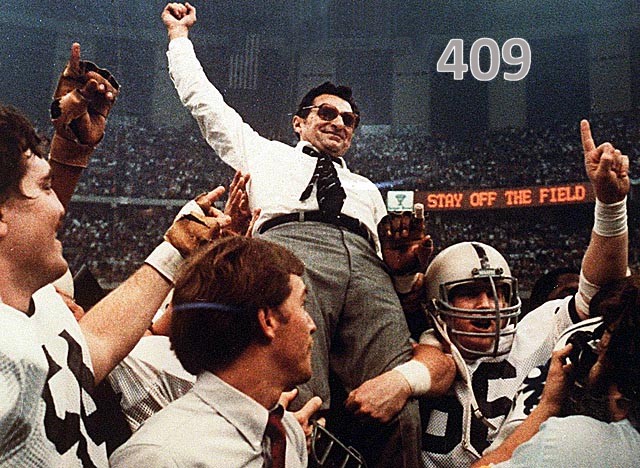 |
| |
|
THE SHIT HITS THE FAN
On November 4, 2011, charges against
Sandusky — which at the time included eight boys —were
officially posted. Sandusky was arrested and released on
$100,000 bail after being arraigned on 40 criminal counts.
There was no football game that weekend.
Saturday, Nov. 5th, was an open date. Maybe that's why
they picked that date to release the news. Sure
enough, the Penn State campus was suddenly under siege. Happy
Valley was inundated with press rushing to report the story.
After a tense weekend, the attorney general held a news
conference on Nov. 7th. It had been three years since
Victim 1 first told his tale of woe to authorities. After the long, strange lull,
things were happening fast now.
On November 7th, Pennsylvania Attorney General Linda Kelly
said Paterno was not a target of the investigation into how
the school handled the accusations.
|
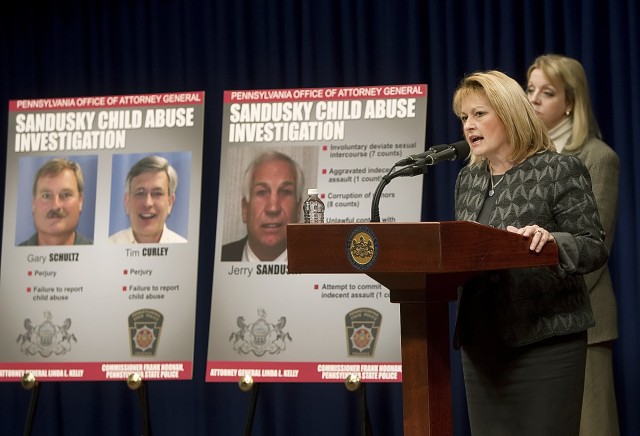 |
But she refused to say the same thing
for Curley and Schultz. They were charged with perjury
and failure to report child abuse. Both men had already stepped down from
their positions. They surrendered on charges that they failed to
alert police to complaints against Sandusky after the 2001
incident. Spanier wasn't charged, but he wasn't in the clear
either. He was still being investigated.
As the news was
released, horror gripped many people. The
public was now aware for the first time of Sandusky's
terrible 2001 crime that had gone unreported and unpunished.
Ten years had passed
since the 2001 incident. People
began to speculate just how many boys had been victimized
since then. A deep sense of revulsion filled their
hearts and minds. How could
anyone set this monster loose on all those children?
As
the news of Paterno’s
true role in
the scandal were made public, calls for the ouster of
Paterno and Spanier began to grow inside
the Penn State community and beyond.
On November 8th, Penn State
abruptly canceled Paterno's regular weekly press conference.
All day long on Tuesday, November 8th,
Penn State was under siege.
People at the University and the entire state were
deeply confused and divided.
Many were outraged at these accusations.
Considering the high esteem people held for Paterno, this
was all a little hard to believe. Surely when more
information was gathered, Paterno would emerge with his
white hat intact. Thanks to
a rampant amount of ignorance and
denial, many people raced to Paterno’s defense.
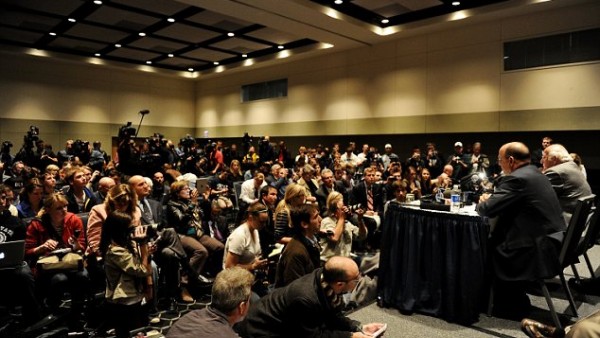 |
On the other hand, there
were countless Paterno accusers as well. If these
stories were correct, Paterno had not only
empowered Sandusky, he had covered for him as well. Those
boys had been raped on Paterno’s watch!
People were aghast at the thought.
Early
the following
day, Wednesday, November 9th, Paterno announced he
would voluntarily retire at the end of the season.
That was fairly ironic because he ended up
getting fired the same day.
In the afternoon, Penn State
held a press conference to say that long-time
coach Paterno had been fired following revelations that he was involved in
the cover-up of sexual abuse by former assistant
Jerry Sandusky. Paterno's
days of dictating his terms to the Board of Trustees
were obviously over.
|
Hundreds of students
gathered at the HUB-Robeson Center, the student
union, to watch the board of trustees' news
conference on a big screen.
When the announcement came
that Paterno would not coach again at Penn State,
students gasped and hushed. Women began to weep.
The entire campus was in shock.
As word of the firing spread, students flocked to
the administration building, shouting, "We want Joe
back!" and "One more game!"
That
evening, more than a thousand Penn State
students moved between the
campus and downtown, chanting Paterno's name
in support of their fallen
coach. They
then headed downtown to Beaver Avenue, where about
100 police wearing helmets and carrying pepper spray
were on standby.
|
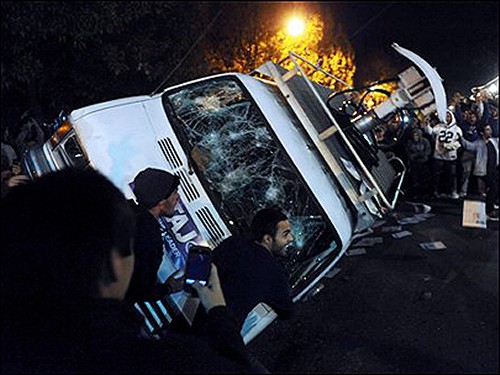 |
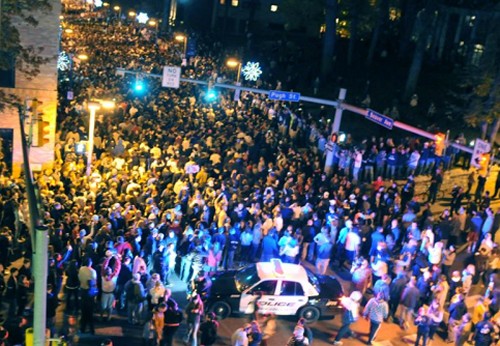 |
Witnesses said some rocks and bottles were thrown, a
lamppost was toppled and a news van was knocked over
and then its windows kicked out.
The police quickly moved in to restore order.
The students didn't get their
wish. Paterno would be nowhere near the
sidelines at the following game on November 12th.
Meanwhile, high school had become unbearable for
Victim 1 after Joe Paterno was fired.
A large group of
misguided jerks blamed the young man for Paterno's
misfortune.
There was relentless bullying of the young man. He
was blamed for getting the greatest coach of all
time fired from his job. And for what? Just
because some horny old coach had diddled with him a
few times? Big deal.
The taunts grew so vicious
that the young man known as "Victim 1" had little
choice but to leave school in the middle of his
senior year and go somewhere else.
|
|
| |
STUPID AS A FOX
With the state of Pennsylvania reeling in a state of shock over the flurry of
horrid events,
there were more Paterno
bombshells on the way.
On
November 15th, the New York Times posted a story
that back in July 2011, Paterno had transferred
ownership of their house to his wife's name for $1.
Was it a
mere coincidence that Joe Paterno transferred his
house to his wife's name mere months before the
grand jury report?
The skeptics suggested that Paterno was likely aware
the Grand Jury report was pending and may have been
trying to protect his assets with the anticipation
that he would be subject to civil lawsuits.
In the
Times article, Lawrence Frolik, law professor at the
University of Pittsburgh, said that he had “never
heard” of a husband selling his share of a house for
$1 to his spouse for tax or estate purposes.
|
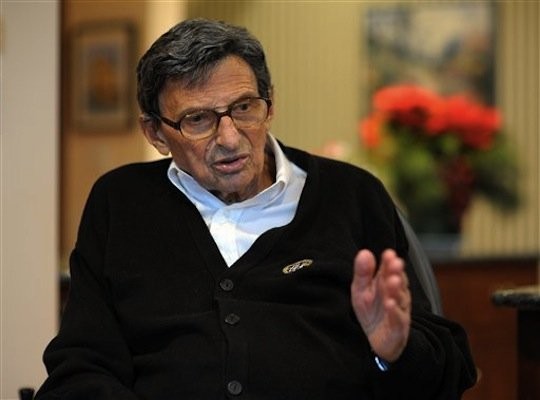 |
“I can’t see
any tax advantages,” Frolik said. “If someone told me
that, my first reaction would be, ‘Are they hoping to
shield assets in case if there’s personal liability?’ ”
Frolik added, “It sounds like an attempt to avoid
personal liability in having assets in his wife’s name.”
The thing that
is interesting about Paterno is that when the heat was on,
he claimed to be naive, unaware, and left out of the loop.
Paterno said he was always the last person to be told
anything.
But in his
private life, Paterno never seemed to miss a beat.
First he renegotiated his contract the moment the Sandusky
issue came up, then he made sure his assets were safe.
Does that sound like the behavior of a man who is always the
last to know?
Whatever Paterno
wanted, he got. The "top administrators" were probably
blackmailed into giving Paterno the new contract.
After all, Joe knew where all the skeletons were buried.
When the new
contract came before the Board of Trustees, they balked
signing off on it. This contract was outrageous!
It was highway robbery. Then they were bombarded with
hate mail and threatened with a defamation lawsuit by Mr.
Paterno’s family. Guess how long it took them to cave
in?
The truth is:
Joe Paterno owned Penn State. Nothing happened on that
campus that Paterno wasn't told about.
But in the end,
Paterno begged the world to believe he was just a feeble,
doddering old man who was
too senile to
grasp all the terrible things Sandusky
was doing behind his back. What happened in his life
to cause this man to lose his conscience?
On November 18th,
Scott Paterno
dropped yet another
bombshell. He announced that his
father had just been diagnosed with a treatable form of lung
cancer. Everyone gasped at
the news. Unbelievable.
It had only been 9 days
since Paterno's firing. Oh well, at least
it's "treatable".
Paterno's last
public words came in an interview with Sally Jenkins of the
Washington Post on January 14, 2012, concerning the Sandusky
affair.
"I didn't
know exactly how to handle it and I was afraid to do
something that might jeopardize what the university
procedure was. So I backed away and turned it over to
some other people, people I thought would have a little
more expertise than I did. It didn't work out that way."
No, it didn't
work out well at all, did it?
|
Joe Paterno
Passes Away
On January 21st, 2012,
it was reported that Paterno was near death.
Paterno family spokesperson Dan McGinn said that "over the
last few days Joe Paterno has experienced further health
complications. His doctors have now characterized his status
as serious."
It was serious all right. One day later Paterno was dead. He
was 85.
Paterno didn’t waste any time dying. Only
three months ago he had a 'treatable' disease. This reinforced
rumors that Paterno was indeed a mythological being.
Quite
clearly Paterno had the ability to will himself to death.
A life without football was a life not worth living.
|
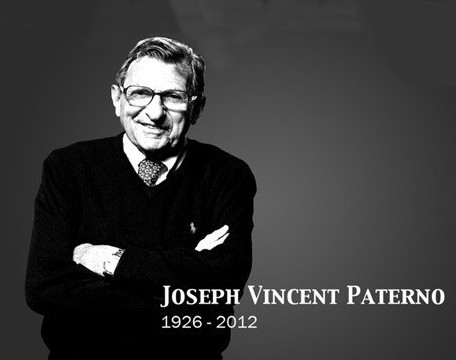 |
| |
|
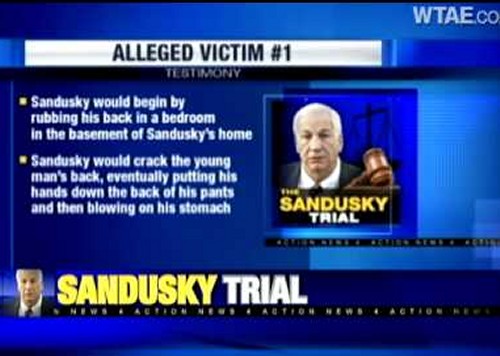 |
SANDUSKY'S TRIAL
In June 2012, the Sandusky Trial
began. Eight witnesses alleged to be former victims of Sandusky
planned to take the stand. The list of people lined up
against Sandusky seemed to guarantee a sure conviction.
Sandusky clearly had a lot of enemies. For example, thanks
to the publicity, on November 8th, a new victim of Sandusky
had contacted state police and offered to testify as well.
He would provide heart-wrenching testimony. People wondered
if there no end to all the boys Sandusky had attacked.
The star witness, of course, was Victim 1. He was the young
high school student who had finally come forward to identify
what Sandusky was doing to him.
This young man deserved a lot of
credit for staying the course. He had been through hell at
his old high school in order to bring Sandusky to trial.
Victim 1 was a pretty brave kid. Uncertain what
Sandusky might do to him, he had been living in fear for the
past three years.
|
Now his testimony would be invaluable.
In addition, Victim 1 had been instrumental in persuading
other victims to come forward as well. Together, their
testimony would surely put Sandusky away for good.
There was one major development when a new hero stepped
forward. During the trial, Matt Sandusky, 33, stepped
forward to offer to testify that he too had been molested.
Matt Sandusky was Jerry Sandusky's stepson.
Matt had not planned on saying
anything. He was just there in the courtroom to watch. However he
became upset because his father's lawyer Amendola repeatedly called
the young men who testified "liars". Now the lawyer
was going to put his step-father on the stand so he could do some
slick talking and win some sympathy.
That didn't happen. Matt
Sandusky said if they put his stepfather on the stand, then
he too would take the stand. Matt told authorities
that he too had been molested. Matt suggested that once
he testified, it was all over for Sandusky. Matt would
have been a very convincing witness.
Not surprisingly, Jerry
Sandusky was not put on the stand after all. Furthermore,
at that point, the lawyer stopped calling
the victims who testified "liars".
Sandusky was ultimately convicted on
45 of 48 counts against. Pending appeal, he would be
going to prison for the rest of his life.
|
HOW COULD WE HAVE BEEN SO
STUPID?
|
Slowly but
surely, back at Central Mountain High
School where Sandusky had gone to pursue Victim 1, the
people began to ask themselves how they had missed so badly
on Sandusky.
One young lady was interviewed.
She said,
"Sandusky's a neat
guy. He's cool, he tells Polish jokes, he's
self-effacing, you know? He's a funny guy. And he
duped us all. 'Dupe' would be, I think, the appropriate
word. He fooled Chet; he fooled me.
Penn State's so big, everyone watches Penn State. It was
amazing to have the famous defensive coordinator come to
little Central Mountain. We're so tiny, we didn't think
anything like that would happen. Mr. Linebacker
Coach himself wants to drive 100 miles roundtrip a day
just to come help us!"
People
were awestruck that such a famous coach would choose their
school. No one seemed to question
“why” Sandusky would choose this particular school which was
located far from Sandusky’s home.
They just took his appearance for granted.
|
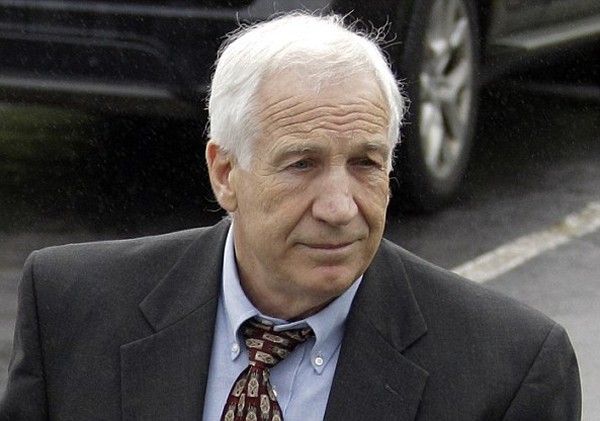 |
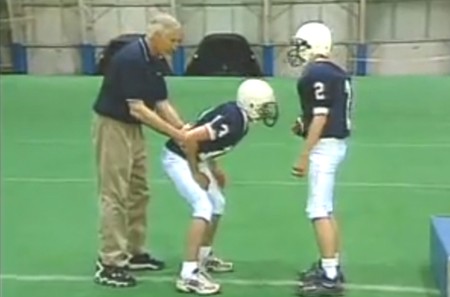 |
Only when
the allegations were revealed did they realize
Sandusky had first come to Central High to pursue
his little buddy.
What
happened after that is not openly talked about in
local coffee shops or at water coolers,
but people began to whisper things. They
agreed Sandusky didn’t always behave
appropriately. Now that they
thought about it, Sandusky was definitely a "hands
on" coach. But no one thought that phrase was
funny.
In
retrospect, everyone began to realize Sandusky did
lots of things that should have raised eyebrows, but
the entire adult community at the school had chosen
to ignore it. Sandusky’s
star power made him nearly invincible for decades,
and there was no exception when he was spending time
in rural Clinton County.
One local
official described Sandusky as walking on water. It
was flattering to have this legendary figure around.
|
One former board member remembered thinking about
how Sandusky really didn’t like socializing with
adults. ‘He just likes kids’, the board member
thought. Another
local official remembered him acting strange — but
only in hindsight. He was always
hugging the boys.
The official didn’t think
twice due to who
Sandusky was,
but now in retrospect that was a giveaway he might
have noticed with a less trustworthy person.
Sandusky simply had
an aura around him that caused even the most
cautious people to disregard small hesitations and
slight oddities that they might otherwise think
twice about.
For
example, the former elementary school wrestling
coach Joe Miller told grand jurors he had observed
suspicious behavior.
Miller testified that he walked in on Sandusky
laying on the floor with Victim 1 after hours one
day.
|
Miller
saw a light on in the weight room and went to turn
it off. He found Victim 1 and Sandusky lying on
their sides, face to face, so close their bodies
were touching, the grand jury report says.
“Sandusky
jumped up and said, ‘Hey Coach, we’re just working
on wrestling moves,’” Miller told the grand jury.
As he
drove home, Miller started to
wonder. Sandusky wasn’t a wrestling coach. He
didn’t know the first thing about wrestling.
Furthermore Victim 1 wasn’t on the wrestling team.
So what was really going on there?
Miller later concluded that
sex offenders are highly skilled at blending in as
normal. It is not really that easy to spot
them. Sandusky was the perfect example.
He was a nice guy. Everyone liked him.
|
 |
If there is one lesson we can all learn from this
story, monsters like Sandusky develop a very
pleasant as a survival mechanism. How else
could they possibly get away with what they do?
Behind
the smile, behind the charitable institution, behind
the volunteer work, behind the funny jokes, a
monster lurks.
These
modern Minotaurs are counting on you and me to give
them the benefit of the doubt the next time they get
caught.
|
|
| |
|
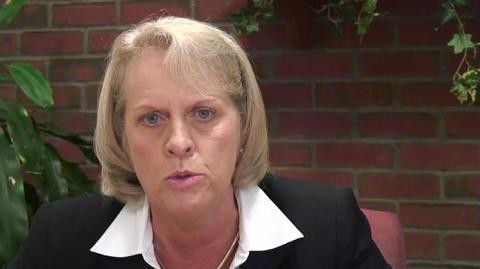 |
VICKIE TRIPONEY
After Paterno’s
death, the lid of secrecy surrounding the Penn State program
was blown sky high. People began to hear stories about
Paterno never previously imaginable.
For the first
time, a new side of Paterno emerged from the shadows. The
man was a serious bully who cared only about his own
reputation. Joe Paterno had a job, and that was to win
games while creating an illusion that Penn State had the
world’s most wonderful football team. Do this and watch the
stands fill with 108,000 fans during football season. Do
this and watch alumni contributions flow into the school’s
coffers.
|
CNN released a story about a woman named Vickie Triponey who
had been swallowed up and eaten alive by the Penn State
jockocracy.
Penn State had
recruited Triponey in 2003 to become the head of student
affairs at Penn State. Triponey had no involvement
whatsoever in the Sandusky matter, but she did have a bird’s
eye view of Paterno’s behavior outside the public eye.
At first Triponey
felt she had the support of Penn State's president, Graham
Spanier, who unabashedly sang her praises when she was hired
and later at professional conferences they both attended.
That changed
quickly when she met Paterno.
Over the next
several years, Triponey would clash often with Paterno over
who should discipline football players when they got into
trouble. The conflict with such an iconic figure made her
very unpopular around campus. For a while, it cost Triponey
her peace of mind and her good name. By the time she
resigned in 2007, her head to head battles with Paterno
almost ended her 30-year academic career.
It started one
day in late 2004. While disciplinary sanctions were being
considered against a member of the football team, Triponey
received a visit from Sue Paterno, the coach’s wife. Sue
Paterno had tutored the player and knew him personally.
‘He's a good
kid’, Sue Paterno said. Could they give him a break?
The player walked
away with little more than a wrist slap.
By the
next year, 2005, she was battling Paterno himself
over who controlled how football players were
disciplined. Paterno chafed over her authority to
enforcing Penn State's code of conduct when it ever
involved one of his players.
Triponey
recalled that President Spanier called a meeting at
which Paterno angrily dominated the conversation.
She summarized the meeting in an e-mail to Spanier,
Athletic Director Tim Curley and others, complaining
that Paterno "is insistent that he knows best how to
discipline his players" and that her department
should back off.
Triponey
noted that Paterno preferred to keep the public in
the dark about player infractions involving
violence, and he pushed for not enforcing the
student code of conduct off campus.
She added
that having "a major problem with Coach Paterno
should not be our concern" in making disciplinary
decisions.
|
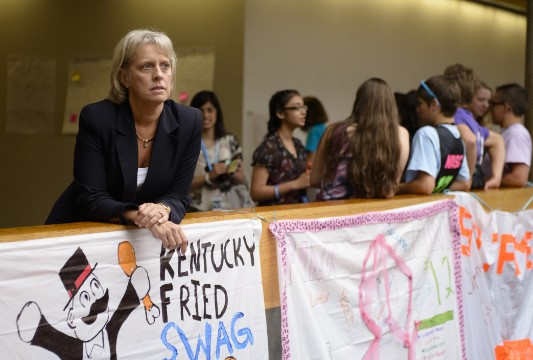 |
"I must insist
that the efforts to put pressure on us and try to influence
our decisions related to specific cases ... simply MUST
STOP," she wrote. "The calls and pleas from coaches, board
members and others when we are considering a case are indeed
putting us in a position that does treat football players
differently and with greater privilege ... and it appears on
our end to be a deliberate effort to use the power of the
football program to sway our decisions in a way that is
beneficial to the football program."
Athletic director
Curley, who had once played for Paterno and was widely
considered Paterno’s "errand boy," responded to Triponey by
explaining "Joe's frustrations with the system" and the
"larger issues that bother him."
Triponey wrote
back, complaining about Paterno's "disregard for our role
and disrespect for the process." She added, "I don't see
how we can continue to trust those inside the football
program with confidential information if we are indeed
treated as adversaries."
Triponey followed
up with another e-mail to Spanier on September 1, 2005,
stating her objection to Paterno's attitude and behavior,
which she called "atrocious." She said others, including
students and their parents, were mimicking him.
"I am very
troubled by the manipulative, disrespectful, uncivil and
abusive behavior of our football coach," she wrote. "It is
quite shocking what this man -- who is idolized by people
everywhere -- is teaching our students."
Triponey saw the
dangers of special treatment that placed football players
under a softer standard than other students lived by. She
said it wasn't right. But whenever she spoke up, Paterno
would shout her down. For his part, Paterno clearly seemed
to resent "meddling" from outsiders, referring to Triponey.
It mattered little to him that Triponey was simply doing her
job. This was a battle she couldn't win.
Paterno ridiculed
her on a radio show as "that lady in Old Main" who couldn't
possibly know how to handle students because "she didn't
have kids."
Tensions reached
the breaking point in 2007 over how to discipline half a
dozen players who'd been arrested at a brawl at an
off-campus apartment complex. Several students were injured;
one beaten unconscious.
Triponey met with
Paterno and other university officials half a dozen times,
although she preferred to remain neutral as the appeals
hearing officer.
At the final
meeting, Triponey urged the coach to advise his players to
tell the truth. Paterno said angrily that he couldn't force
his players to "rat" on each other since they had to
practice and play together. Curley and Spanier backed him up
on that point, she said.
Triponey
recommended suspensions; Paterno pushed for community
service that included having the team clean up the stadium
for two hours after each home game.
In the end, four
players were briefly suspended during the off-season. They
didn't miss a game.
By then it was
clear Triponey no longer enjoyed Spanier's support. He began
making noises about whether she really embraced "the Penn
State way." He told her during an annual review that she was
too confrontational, too aggressive. Triponey knew her days
at Penn State were numbered when he advised her to think
hard about whether she had a future there.
When it all fell
apart, Triponey felt completely alone. Paterno expressed
his frustration with Triponey to anyone at the University
who would listen.
Now she received
threatening phone calls at home when her husband was
traveling and was savaged on student message boards. Her
house was vandalized and "For Sale" signs were staked in her
front yard. By the time police installed surveillance
cameras, she was already on her way out.
President Spanier
came to her home and sat in her living room shortly after
Paterno lost his temper at the meeting about the players
involved in the brawl. She said Spanier told her, "Well,
Vicky, you are one of a handful of people, four or five
people, who have seen the dark side of Joe Paterno. We're
going to have to do something about it."
Triponey would
shake her head as she recalled that conversation. "As it
turned out, ‘Doing something about it’,'" she says, "ended
with me being gone."
Citing
"philosophical differences," Triponey resigned under
pressure as the 2007 football season got under way. Unlike
Sandusky, convicted of molesting young boys, she did not
receive a $168,000 golden handshake, prime football seats
for life or keys to the locker room.
Once she lost her
battle with Paterno, her life in the Penn State environment
was over.
She was no longer
invited to events. She was shunned. She stopped going to
Wegman's, a favorite upscale supermarket outside State
College, because "the Penn State people went there." They
recognized her and without fail turned their backs and
walked away, she recalled.
Triponey sold her
big house in State College and moved into a condo. Meanwhile
her husband, a Penn State professor, looked for a job at
another university. It took two years, but he finally found
a spot at the Medical University of South Carolina in
Charleston.
Former colleagues
who did want to reach out held back. Later, they explained
that they were afraid of losing their jobs, too.
That, she says,
was "the Penn State way" as she knew it.
It had been
corrupted by success.
"Winning became
more important," Triponey said, along with a strong desire
"to avoid bad publicity." So many people were invested in
the football program, they felt they had "to protect
something that they had created, a grand experiment that was
so perfect that they didn't dare let anybody know there were
blemishes."
There was no
accountability. Board meetings were scripted to avoid
controversy. It was a point of pride that nobody ever
argued. The leadership was "grounded in the spin, the image,
the 'too big to fail.' It became a business dependent on the
money and contributions," she said.
She thought she
had left academia forever, following her husband to
Charleston and getting involved in charities and community
work.
"At the time, the
controversy destroyed my career. I couldn't go back into
higher education after what happened at Penn State. No one
would dare touch me. I had to leave the work I had done for
30 years. What enabled people to take a chance on me was
when the Sandusky story broke."
"Now the world of
higher education started seeing me as a more credible
person," Triponey said. "I did get messages and kudos. Now
that the truth was out, I was offered jobs again. I was
shocked. I never thought I'd be back doing work in higher
education," she said. "I also never thought I'd see the day
where public opinion is at the place where folks are saying
Penn State's culture has got to change."
As for Paterno,
who died of lung cancer in January, Triponey had this to
say.
"Joe Paterno was
once an incredibly principled person," she said, recalling
how at the beginning he made sure his athletes were
successful students.
"That was at his
core," she said, "but when the pedestal became so high, he
lost that somewhere. Power corrupts."
|
| |
|
LACK
OF INSTITUTIONAL CONTROL
Several people
besides Vickie Triponey pointed to
the lack of institutional control at Penn State.
Although
theoretically the football coach serves at the behest of the
Athletic Director and the school President, at Penn State
these roles were clearly reversed.
Although Joe
Paterno’s position gave him absolutely no say-so in
institutional matters, no one dared stand up to him.
One need look no
further than the salaries to discern which man was more
important to the university. Paterno made a total of
$1,022,794 while President Graham Spanier made $813,855
Throughout the
2000s, Paterno had a contentious relationship with some
members of the Board of Trustees. They actually tried to
oust him after a series of losing seasons.
|
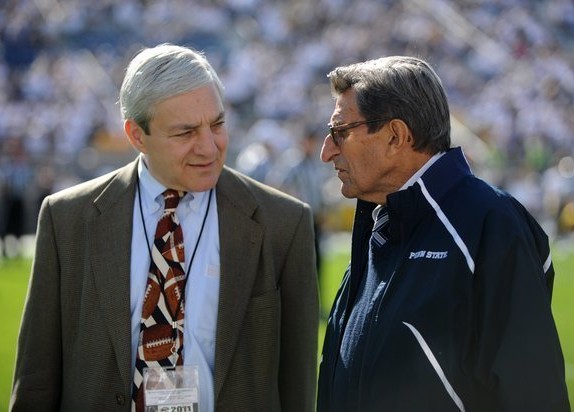 |
After Sandusky
left the program in 1999, Paterno seemed to slip a notch.
Paterno had five
losing seasons in a row. During the period from 2000 to
2004, Penn State had a losing record of 26-33.
As it turned out,
harboring a sexual deviate was hardly any reason to get rid
of Paterno according to the fan base.
But let him lose a few games and suddenly the fans called
for his removal.
Prompted by
criticism from alumni, fans and the media, university
officials and select board members decided it was time for
Paterno to go. Paterno's
doorbell rang Nov. 21, 2004. It was a Sunday morning. Penn
State had lost the day before to finish the season at 4-7.
The officials weren’t wasting any time.
Four high-ranking
Penn State officials, including university president Graham
Spanier and athletic director Tim Curley, walked into
Paterno's home and told him, for the second time in less
than two weeks, that they wished him to stop coaching,
either at that minute or very soon.
Paterno
stubbornly and selfishly refused to go.
Paterno said he would be the sole determiner of when he
would retire. Relying upon the deep reservoir of good will
he had accumulated within the vast Penn State community
during his long career, Paterno pointed out that he was
untouchable. They wouldn’t dare remove him against his
will. One snap of his fingers and
watch those donations dry up.
Then Paterno
pointed to the door. They left quietly. Nothing more was
said or done about Paterno’s job.
Paterno was
right. No one had the guts to stand up to him.
This quote from Sports Illustrated
sums it up nicely.
"In 2004, on the heels of two straight
losing seasons, Spanier and Curley went to Paterno's home to
ask the coach to retire, only to slink meekly away after
Paterno refused. This moment made a mockery of the
kind of reporting structure that marks a healthy
institution."
|
| |
|
SPORTS ILLUSTRATED
Back in 1999, Jack McCallum of
the renowned
magazine Sports Illustrated had written a
very nice piece about Sandusky's retirement.
Now it was November 2011
and the truth was out.
McCallum burned with embarrassment. He
felt like he had egg on his face.
He
could not believe how easily
he had been
deceived by Sandusky’s bald-faced lies to explain his
mysterious retirement in 1999.
Sports Illustrated
was going to get it right this time. It
sent McCallum and several other
reporters back to the campus to take another look at the
sterling Penn State reputation.
It was now
obvious to everyone that Paterno had engaged in a cover-up
just as extensive and manipulative as anything the Nixon
team had ever attempted.
In 1998 Paterno
had hushed up Sandusky’s transgressions and swept them under
the carpet. Doing anything more at the time would have
brought a raft of bad publicity. He
had done it again in 2001.
Joe’s “unbeaten”
reputation for running the cleanest football program in
history would have taken a major blow. Donations might have
trickled down. Why not just hush it
all up?
Paterno’s
decision to take the easy way out would have terrible consequences. From that point
on, he embarked on an endless series of efforts to bully
people to look the other way whenever his players or his
sexual monster stepped out of line.
"Penn State will
never fully get its reputation back as the guys in the white
hats," says Charles Yesalis, a retired Penn State health
policy and sports science professor. "Part of that was smoke
and mirrors."
|
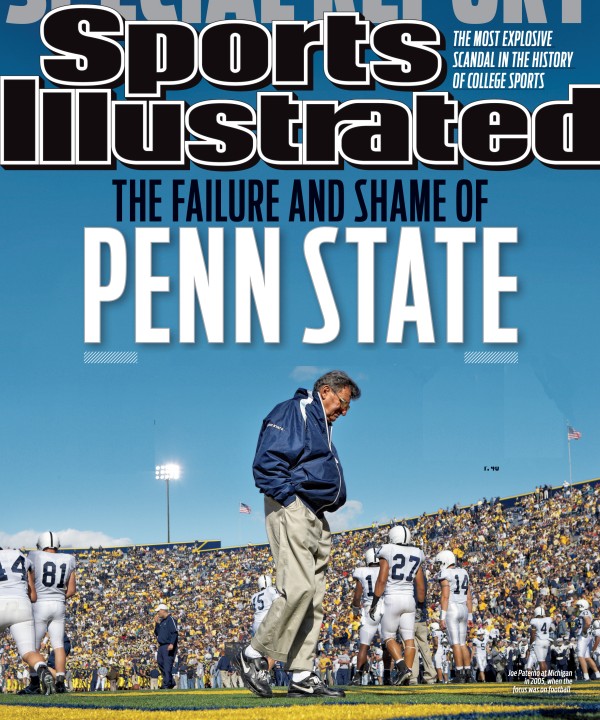 |
Mary Gage, former
director of the undergraduate fellowships office at Penn
State, said, "It's amazing to think what one man can do to a
whole heroic institution if the reaction is faulty."
While the Nittany Lions eagerly trumpeted to recruits that
they had never faced serious NCAA scrutiny or sanction,
closer inspection revealed it has hardly been a spotless
program. Three years ago
ESPN reported that between 2002 and '08, 46 players had been
charged with a total of 163 crimes ranging from public
urination to murder.
In March, SI
published arrest tallies for all the programs in its Top 25.
Penn State tied for fourth, with 16 players on the 2010
opening-game roster who had been charged with a crime.
Harrisburg's
Patriot-News, which first broke the story of the Sandusky
investigation in March 2011, made passing reference to "a
player-related knife fight in a campus dining hall" that was
broken up by assistant coach Mike McQueary in 2008.
In 2005,
defensive end LaVon Chisley was quietly kicked off the team
for academic reasons and, according to prosecutors, began
racking up debts. He was never drafted, and that summer he
murdered his former roommate, a campus marijuana dealer.
Chisley is serving a life sentence. Yet when asked about the
incident at a press conference after the conviction, Paterno
brushed it aside: "I have no comment on that.... Why should
I?"
And when ESPN
questioned Paterno about the spate of player arrests, he
responded, "I don't know anything about it."
In 2003, after
Tony Johnson, a wide receiver and the son of a Penn State
assistant coach, was arrested for DUI, Paterno complained
that "it will get all blown out of proportion because he's a
football player. But he didn't do anything to anybody."
While the coach apologized for that last remark, the smoke
and mirrors illusion of Penn State as a haven of virtue—at
least by the limbo-bar standards of big-time college
football—persisted.
Karen Muir, a
State College attorney who has represented Penn State
football players in legal trouble, said she has seen
firsthand how the team will sacrifice an individual for the
sake of the program. After Penn State defensive tackle Chris
Baker, later an NFL player, was involved in two off-field
fights, Muir said she planned to go to trial to defend him
from criminal charges. The coaches prevailed on her client
to take a plea bargain, thus sparing the program protracted
embarrassment.
"My experience is
that Penn State football closes ranks and their focus is on
the program as opposed to the individual," Muir says. "The
program didn't care as much what was best for my kid."
|
| |
|
|
|
END GAME:
THE
FREEH REPORT IS RELEASED
During a news
conference in Philadelphia on July 12, Judge Louis Freeh released the
267-page report. People gasped. This was
a very powerful document.
After giving everyone an hour to read,
the former FBI director
fielded questions from reporters about his team's findings.
Freeh began by saying he
believed that Spanier, Schultz,
Paterno and Curley concealed information in order to "avoid
the consequences of bad publicity."
In other words, a cover-up.
When asked by reporters if held the most responsibility in
the endangerment of children, Freeh said that the coach and
the three administrators were equally responsible, but he
was shocked that Paterno didn't take more steps throughout
the years to ensure that Sandusky did not have access to
university facilities.
|
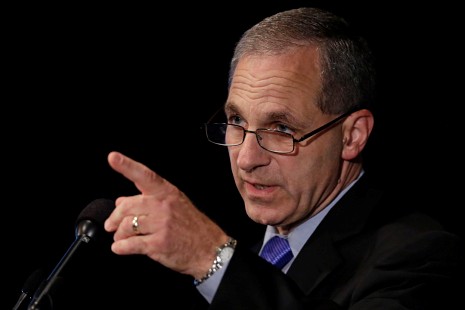 |
Since many reporters' questions
kept the attention on Paterno, Freeh made
it a point to single out Paterno. Of all the men
involved, Joe
Paterno, the school's legendary head football coach,
could have stopped the attacks had he
raised even a single finger.
"At the very
least, Paterno could have alerted the entire football staff
in order to prevent Sandusky from bringing any other
children into the Lasch Building," Freeh said.
"Our most
saddening and sobering finding is the total disregard for
the safety and welfare of Sandusky's child victims by the
most senior leaders at Penn State," Freeh wrote. "The most
powerful men at Penn State failed to take any steps for 14
years to protect the children who Sandusky victimized."
One question asked whether "the
football culture" at Penn State led the four men to actively
conceal information about Sandusky's actions.
Freeh replied that one of
the biggest indicators of the decayed
"culture" at Penn State was testimony from university
janitors. Several janitors witnessed what Freeh called
Sandusky's "most horrific" sexual assaults but they
"panicked" and did not report what they saw, in fear of
losing their jobs.
"If that's the culture on the bottom, then God help the
culture on the top," Freeh said.
One of the final questions Freeh fielded was whether or not
Penn State is a safe university for parents to send their
students.
"I think parents should be comforted and assured at this
point that when sending their kids to Penn State, they will
be safe,” Freeh said.
As the news spread, the Freeh
Report shocked the nation. The
Grand Jury report had been more about Sandusky.
However this document focused directly on the Penn
State administration.
It was so thorough that any
doubts about Paterno's innocence rapidly
disappeared.
The Freeh
Report said the most powerful leaders at Penn State
University showed "total and consistent disregard"
for child sex abuse victims while covering up the
attacks of a longtime sexual predator.
People were appalled to
discover that Penn State officials – including Joe
Paterno – could knowingly allow a child molester to
operate in their midst and did nothing to stop it.
How could these men allow all those boys to be
attacked on their own premises?
What was
worse was when the
four men learned of Sandusky’s crimes,
they
not only denied any knowledge, not once did these
men show the slightest remorse or concern for
the children who had their lives ruined.
|
 |
Sandusky was
portrayed in the report as the embodiment of unadulterated evil, a coldly
manipulative serial sexual predator. Often through the
access he gained by way of The Second Mile, the report
alleged, Sandusky first built trust and relationships with
young boys—vulnerable, socially at-risk kids from his own
foundation—then sexually assaulted them.
The report alleged
that between 1994 and 2009, Sandusky abused
a minimum of eight boys.
Freeh acknowledged there were
undoubtedly countless more.
Sandusky was fortunate that the stigma and fear of
embarrassment kept many of his victims from stepping up.
Nevertheless, shortly after
the report was released,
Freeh's words about more victims rung true. Three more men stepped out of
the shadows to tell investigators that Jerry Sandusky had
molested them in the 1970s and 1980s. This development
not only stretched Sandusky's Crime Timeline 20 years
earlier, it increased the likelihood there are many more
victims still out there.
The report
reminded everyone again that Sandusky
deliberately traded on his status as a Penn State
football demigod. Many of the alleged assaults occurred
either in the university's football facilities or at
football functions. The Nittany Lion program became
Sandusky's bait. He brought victims to games at State
College, allowed them to attend coaches' meetings,
facilitated their meeting players, cast them in
instructional videos, and in one case
even had the nerve to take a boy to the
Alamo Bowl, in San Antonio, where he was
able to bully the small boy into submitting to his desires.
The world
recoiled in horror. They had found
the devil in Jerry Sandusky. They had lost their saint
in Joe Paterno.
|
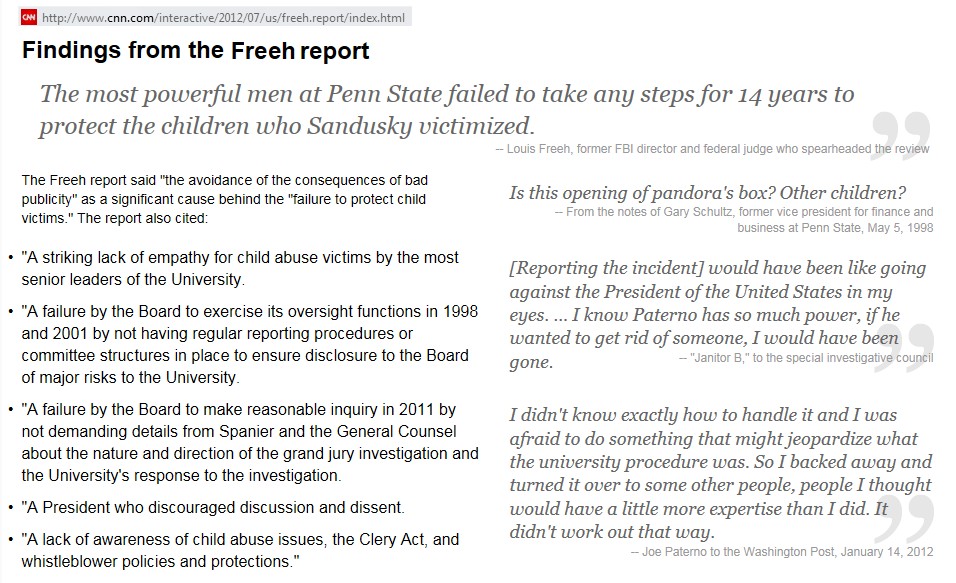
|
THE NCAA PENALTIES
The Karma
unleashed by the
Freeh Report
hit Penn State
smack in the face. The entire football program at Penn State was hit by
the NCAA with perhaps the most severe penalties in
college football history.
In
addition to losing scholarships and being fined an
incredible amount of money, the school was stripped
of all its victories since 1998. 111 victories were
instantly turned into defeat. Joe Paterno would no
longer be known as the most victorious coach in
college football history.
In
addition, on July 23rd, the now-deceased
Paterno had his statue removed at Penn State and
placed in hiding.
Joe Paterno’s
descent from the pinnacle to abyss was compete. It
had taken place with blinding speed. From now on,
Paterno’s legacy would be permanently tarnished.
|
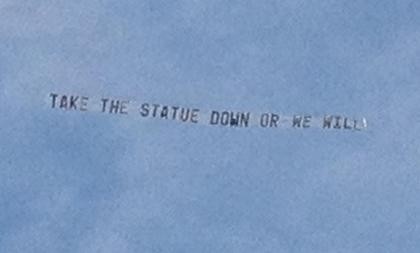 |
|
|
|
Say It Ain’t So,
Joe!
|
|
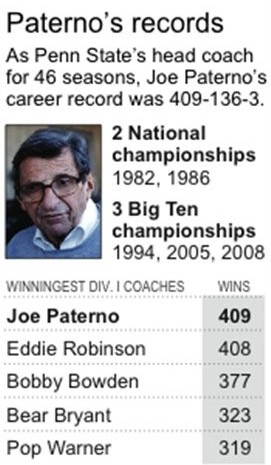 |
They say the most
important thing a man takes to his grave is his
reputation. For most of
his life, Joe
Paterno had one of the finest reputations
in the world.
Paterno
was
definitely a great coach. Paterno coached 548
games spread out over a record 46
seasons. During this time, Penn State won two
national championships. It had five perfect seasons.
Penn State won 24 out of the 37 bowl games that it participated
in.
Paterno was named National Coach of the
Year five times, the most of any coach in history.
Penn State finished in the Top 25 national rankings
35 times.
Paterno
was on the verge of being known forever as the
greatest coach in history and being
considered a man of
unquestioned integrity for
eternity.
Instead
his reputation went up in a blaze of smoke.
Henceforth the name ‘Paterno’ will be doomed to
conjure up images as the callous jerk who let his
sick buddy rape little boys.
Any human being with an ounce of decency would do
something to stop
it. Not Paterno.
The level
of disgust that people feel is almost without end.
In the
end, the question has to be asked. What
caused his fall from grace?
As the
Vickie Triponey story makes clear,
Paterno had strong
values in the beginning. However, at some point
Paterno turned into something
more
resembling a driven megalomaniac.
He
terrorized anyone who stood in his way,
rationalizing that the glory of Penn State far
surpassed any trivial concerns. If
a few people got hurt because they got in his way,
tough. Penn State and Joe Paterno's football
team are a lot more important than they are.
|
THE DEAL WITH THE
DEVIL
Paterno took his
secrets to the grave. This is just
speculation.
Did Paterno
make a Deal with the Devil? When the
Sandusky problem crossed his desk for the
first time in 1998, Paterno was
riding high. His team had just finished 9-3
and had a loaded team back for the following season.
What was Paterno
supposed to do with Sandusky? I doubt
Paterno and Sandusky even talked about what
had happened. Paterno was old school.
He wasn't happy to have a homosexual on his
staff, but it wasn't a topic he could talk
about openly.
If he simply tossed
Sandusky out, surely the
reporters would flock to campus and ask
questions. Full of bitterness, it is likely
the man would talk at some point. Better to keep
Sandusky happy. The simple thing to do
was keep the guy around.
|
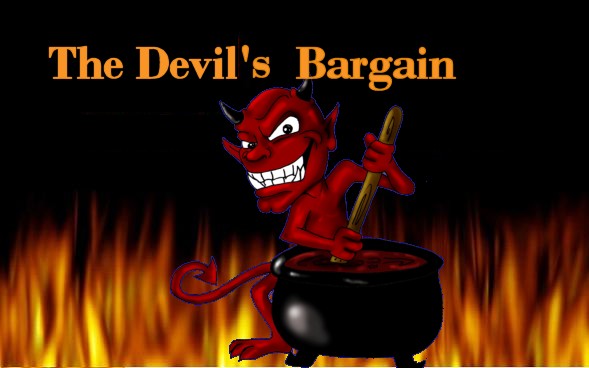 |
|
The greatest cover-up in sports history probably
began because
Paterno simply decided to do
nothing but let Sandusky keep his job.
We will never know the truth.
Not one story has emerged about any conversation
between Paterno and Sandusky that I could find.
Sandusky
had told the police he had learned his lesson. He
had admitted what he had done with that little
boy was wrong.
Paterno decided to
roll the dice and pretend nothing had
happened. That was the worst mistake of his
life.
He should have turned the guy
in, called a press conference, and explained what
Sandusky had done. Sure
there would have been consequences, but up to this
point, Paterno had done nothing wrong. He
still wore the white hat.
|
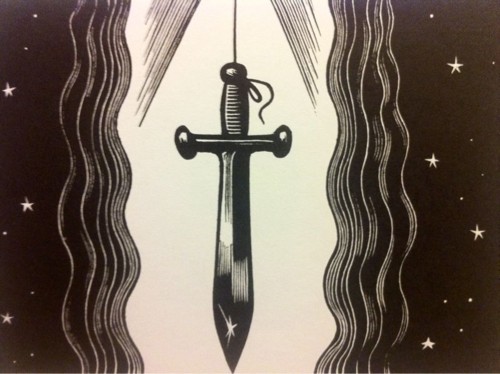 |
Instead, by doing nothing,
Paterno was
now complicit in Sandusky's evil.
If Sandusky
got caught, Paterno would likely get caught as well.
Sandusky's very existence would become an ongoing
threat to Paterno.
This threat hung
over Paterno's neck like the proverbial Sword of
Damocles. Sandusky owned Paterno and he knew
it. He
kept bringing those little boys on campus because he
felt invulnerable.
Pal Joey would always cover
for him. And since Paterno had brought
Curley, Moe, and Larry in on the deal, the Three
Stooges were just as vulnerable to Sandusky's
peculiar insanity as Paterno was.
What a horrible irony.
By simply doing nothing, the glory of the Penn State
football program permanently tied to the
whims of a sex offender.
Paterno's solution was to
build an iron-clad cover-up. But surely he had to
know the risk he was taking. One mistake on their
part or one mistake on Sandusky part and this terrible secret would be released to
the world.
|
For the
next two football seasons, Paterno let Sandusky hang
around. But their relationship deteriorated
thanks to the hideous secret they shared.
Paterno's likely revulsion surely helped poison any
warmth he had once felt for the man. For his
part, Sandusky surely grew to dislike the hypocrite
that Paterno had become.
Paterno
couldn't take it any more. In May 1999,
he told Sandusky to finish out the '99 football
season and then quit. He couldn't stand having
the monster anywhere near him.
After
Sandusky left, people have asked why Paterno didn't
take the keys away. I doubt the two men were
even on speaking terms. Paterno more likely
kept as much distance as he possibly could.
Paterno was part of a generation that simply didn't
talk about this stuff.
Who
knows what happened over the next few years.
There was the 2000 incident witnessed by the
janitors. Is it safe to guess there were other
incidents that never even came to light?
In 2001,
Sandusky got caught again when McQueary
spotted him. This poor football assistant
was in the wrong place at the wrong time.
If there is one person I actually feel sorry
for in this whole sordid mess, it is him.
Once again the cover-up came through for
Paterno and Sandusky, but in the process the Three Stooges made a serious mistake.
Paterno and the
Three Stooges were so appalled by what Sandusky was doing in the
Penn State showers they couldn't take it any
more.
This time Schultz, the athletic director,
was giving the unpleasant task of taking the
keys away and suggesting
Sandusky take his nasty habit off
campus. In other words, they would cover for
him again, but don't come around here any more.
Sandusky was banned him from the athletic center.
This was bad move.
As
several writers pointed out, had Sandusky remained
under Paterno's protection, it is unlikely any word
could possibly escape Joe Pa's iron curtain.
|
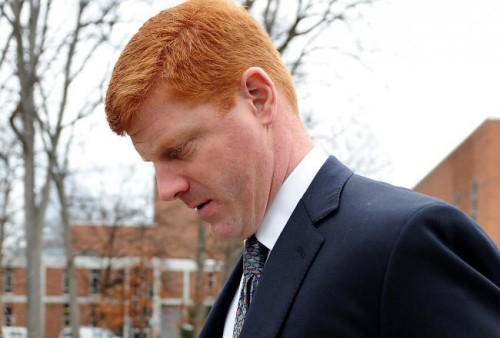 |
However,
by cutting Sandusky loose, they lost control of
their invisibility cloak. What an incredible
risk they were taking!
The
Stooges got away with it in 2002, but they had to
know this was a time bomb waiting to happen.
Tick tick tick. 2003. Tick tick tick.
2004. Tick tick tick. These were years
Sandusky was raping little boys who screamed for
mercy in his basement. 2005. Tick tick
tick. 2006. Tick tick tick. The remarkable
thing is that Sandusky got away with his sickness as
long as he did. 2007. Tick tick tick.
Then it
was 2008.
Sandusky slipped up again while chasing Victim 1 at
Central Mountain High School. The police were
called and the time bomb went off.
The
problem was the Stooges never heard the explosion. Clinton County was way off their
radar. There was no one over there who had any
inkling
Sandusky's crime had the slightest thing to do with Penn State.
When the
officials of this county some 40 miles away from
State College began their investigation in 2008,
they deliberately kept the investigation quiet.
This meant the Penn State officials had no idea time
was running out until it was too late. When
the sordid mess exploded, Paterno and the Three
Stooges were completely blind-sided. It was
too late to contain this problem. Chernobyl
had blown its top. This radioactive garbage
was loose.
Cover-ups are never easy to maintain. So why
did Paterno do the cover-up in the first place?
After all, it wasn't Paterno's fault that Sandusky
was a pervert. If Paterno had just done the
right thing at the right time, his previous perfect
record would have given him all the credibility he
needed to survive the hit. Sure it would have
been embarrassing, but Paterno would have ridden it
out.
Put
Sandusky in jail and hit the recruiting trail hard.
If anything, maybe Paterno would get some kudos for
handling a tough situation with integrity.
In the
end, Paterno simply didn't think straight. He
figured he could tiptoe his way through this
madness. Uncle Jerry had promised to be a good
boy from now on. Why not take the easy way
out?
After
all, who wants to take a chance of killing the
Golden Goose? The risk of telling the truth
had to terrify Paterno. Louis Freeh himself
speculated that they were all terrified of the bad
publicity.
A
2010 study said the
Penn State football program had a $161.5
million impact on Pennsylvania in 2009. The football
team made a $53.2 million profit in 2010, according
to CNN Money. The school made $24 million more
through general merchandise sales.
Furthermore, Penn State continued to be one of the
major college leaders in alumni donations, many of
whom give because they love their Nittany Lion
football team.
Surely Penn State made similar
dollars in 1998. Lots of school programs depended on
that money. In a sense, Penn State had become
too big to fail. The economy of the State of
Pennsylvania was far too intimately wrapped around
the fortunes of Penn State football... or at least
Paterno might have thought so.
What a horrible mistake.
The tension must have been unbearable. Like
Anne Frank waking up every day of her life wondering
if this would the day the Nazis would be coming for
her, I wonder if those four men spent all those
years in a constant state of nausea. Or did
they simply live in denial? Tick tick tick.
Who can live this way? What the hell were they
thinking?
The Three Stooges weren't bad
men. They weren't evil.
They were stupid men.
They were stupid, ignorant men who let Paterno push
them around.
Schultz was no fool. He
had asked the right questions from the start. "Is
this opening of pandora's box?" he wrote in personal
notes on the case. "Other children?" "Sexual
improprieties?"
Curley was no idiot. Nor was Spanier.
According to Freeh, Spanier, Schultz and Curley were
set to call child services on Sandusky in February
2001 until Paterno apparently talked them out of it.
Curley later admitted he wasn't "comfortable" going
to child services after that talk with Paterno.
All four men were linked
together in the Devil's Bargain. If even just
one of them spilled the beans, the cover-up would
have been blown to pieces. One of the unsolved
mysteries is who tipped off the Grand Jury about
Mike McQueary. The secret of the heinous 2001
incident was revealed in an anonymous email.
Who knows... maybe one of the Stooges had a pang of
conscience.
But given how much they lied,
probably not. They were weak men who let
themselves be dominated by Paterno's iron hand.
The administrator's were not
the only weak ones. The Board of Trustees got
chewed out as well.
Louis Freeh criticized the Board of
Trustees for its weak oversight of the senior
university officers. The Board failed to
create an atmosphere "where the president and senior
officers felt accountable to the board."
Mark Emmert, president of the
NCAA, had this to say when handing out Penn State's
punishment.
"One
of the grave dangers stemming from our love of
sports is that the sports themselves can become
too big to fail, indeed, too big to even
challenge. The
result can be an erosion of academic values that
are replaced by the value of hero worship and
winning at all cost."
In the
wake of the Penn State scandal, the question now is
whether educators will learn
anything. Will they have the guts to
fight powerhouse sports programs running amok?
Will they insist on transparency – the very
thing Paterno fought tirelessly against?
Only time will tell if any
good comes from this scandal. I suppose the
NCAA stripped all those victories from Penn State because they
wanted to send a message to all the other sports programs out there
who might be hiding something.
"Confess now or lose all your
victories."
Personally, I wouldn't be surprised if one of these days Penn State
will get its victories back.
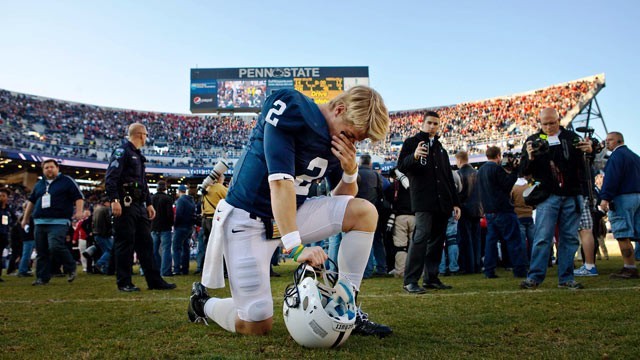 |
Right now the world is angry. When people calm down, they will
realize those football players didn't do
anything wrong. Those victories were won fair and square.
A
better punishment might be to strip Paterno of his victories, but
let Penn State keep its record.
But
ultimately, I really don't give a damn whether Penn State gets it victories back.
When
you think of some poor little boy screaming in pain down in the
basement of Sandusky's House of Horror, not one single victory
matters the slightest bit.
Those
boys were raped because Sandusky was allowed to roam free.
Sandusky roamed free because Paterno didn't want to see his precious
football program sullied by its association with the monster.
|
It has
been said that evil triumphs when good men do
nothing. I cannot imagine a
more fitting comment.
There are many who
have shed tears for
Joe Paterno. Lots of people
feel sympathy for Joe Paterno.
Not me.
Nor am I alone.
As I have made clear, Paterno was not only a bully
who hurt a lot of people in his career, he was
despicable beyond comprehension for sacrificing
those boys to the beast.
For
the rest of time, I will remember Paterno as the man who looked away while
little boys were raped by the Minotaur.
I will save my tears for
the boys who were brutally assaulted while men
who should have known better
— including Joe Paterno – did nothing
to protect them.
Coach Paterno's reputation is now
permanently destroyed. He got what he
deserved.
If one
good thing can come from Paterno's story, it will be this:
There is evil in the world. If the
moment ever comes when I see someone being hurt by a bully, I hope
this story will give me the courage to stand up to the bullies and
blow the whistle.
After
all, isn't that the moral of this story?
Every
time we look the other way, every time we turn a blind eye, the Devil will triumph and
the Minotaur will roam free.
|
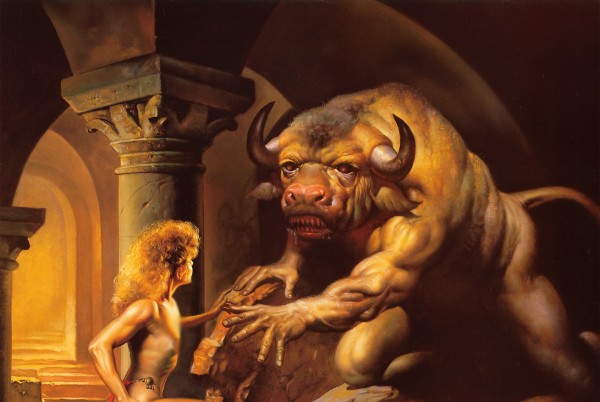 |
Rick
Archer
August 2012
rick@ssqq.com
|
|
| |
Joe
Paterno's True Legacy
Article Written by Rick Reilly, ESPN.com
(Rick
Archer's Note: In my opinion, Rick Reilly is the
finest sportswriter in the business. I followed his
stories for many years at Sports Illustrated and now he
writes for ESPN. In the following article, Mr. Reilly
writes a compelling epitaph on the Paterno legacy.)
What a fool I was.
In 1986, I spent a week in State College, Pa., researching a
10-page Sports Illustrated Sportsman of the Year piece on
Joe Paterno.
It was supposed to be a secret, but one night the phone in
my hotel room rang. It was a Penn State professor, calling
out of the blue.
"Are you here to take part in hagiography?" he said.
"What's hagiography?" I asked.
"The study of saints," he said. "You're going to be just
like the rest, aren't you? You're going to make Paterno out
to be a saint. You don't know him. He'll do anything to win.
What you media people are doing is
dangerous."
Jealous egghead, I figured.
What an idiot I was.
25 years passed. In November 2011,
when former Penn State defensive coordinator Jerry Sandusky
was accused of a 15-year reign of pedophilia on young boys,
I immediately believed Paterno was
too old and too addled to understand, too grandfatherly and
Catholic to get that Sandusky was committing grisly crimes
using Paterno's own football program as bait.
But I was wrong. Paterno knew. He knew all about it. He'd
known for years. He knew and he followed it vigilantly.
That's all clear now after Penn State's own investigator,
former FBI director Louis Freeh, came out Thursday and hung
the whole disgusting canvas on a wall for us. Showed us the
emails, read us the interviews, shined a black light on all
of the lies they left behind. It cost $6.5 million and took
eight months and the truth it uncovered was 100 times uglier
than the bills.
Paterno knew about a mother's cry that Sandusky had molested
her son in 1998. Later, Paterno lied to a grand jury and
said he didn't. Paterno and university president Graham
Spanier and vice president Gary Schultz and athletic
director Tim Curley all knew what kind of sick coach they
had on the payroll in Sandusky. Schultz had pertinent
questions. "Is this opening of pandora's box?" he wrote in
personal notes on the case. "Other children?" "Sexual
improprieties?"
It gets worse. According to Freeh, Spanier, Schultz and
Curley were set to call child services on Sandusky in
February 2001 until Paterno apparently talked them out of
it. Curley wasn't "comfortable" going to child services
after that talk with JoePa.
Yeah, that's the most important thing,
Joe, your comfort.
What'd they do instead? Alerted nobody. Called nobody. And
let Sandusky keep leading his horrific tours around campus.
"Hey, want to see the showers?" That sentence alone ought to
bring down the statue.
What a stooge I was.
I talked about Paterno's "true legacy" in all of this.
Here's his true legacy: Paterno let a child molester go when
he could've stopped him. He let him go and then lied to
cover his sinister tracks. He let a rapist go to save his
own recruiting successes and fundraising pitches and
big-fish-small-pond hide.
Here's a legacy for you. Paterno's cowardice and ego and
fears allowed Sandusky to molest at least eight more boys in
the years after that 1998 incident -- Victims 1, 2, 3, 4, 5,
8, 9 and 10.
Just to recap: By not acting, a
grown man failed to protect at least
eight boys from years of molestation, abuse and
self-loathing, all to save his program the embarrassment.
The mother of Victim 1 is "filled
with hatred toward Joe Paterno," the victim's lawyer says.
"She just hates him, and reviles him." Can you blame her?
What a sap I was.
I hope Penn State loses civil suits until the walls of the
accounting office cave in. I hope that Spanier, Schultz and
Curley go to prison for perjury. I hope the NCAA gives Penn
State the death penalty it most richly deserves. The worst
scandal in college football history deserves the worst
penalty the NCAA can give. They gave it to SMU for winning
without regard for morals. They should give it to Penn State
for the same thing. The only difference is, at Penn State
they didn't pay for it with Corvettes. They paid for it with
lives.
What a chump I was.
I tweeted that, yes, Paterno should be fired, but that he
was, overall, "a good and decent man." I was wrong. Good and
decent men don't do what Paterno did. Good and decent men
protect kids, not rapists. And to think Paterno comes from
"father" in Italian.
This throws a can of black paint on anything anybody tells
me about Paterno from here on in.
- "No NCAA violations in all
those years." I believe it. He was great at hiding
stuff.
- "He gave $4 million to the
library." In exchange for what?
- "He cared about kids away from
the football field." No, he didn't. Not all of them. Not
when it really mattered.
What a tool I was.
As Joe Paterno lay dying, I actually felt sorry for him.
Little did I know he was taking all of his dirty secrets to
the grave.
Nine days before he died, he had
The Washington Post's Sally Jenkins in his kitchen. He
could've admitted it then. Could've tried a simple "I'm
sorry." But he didn't. Instead, he just lied deeper. Right
to her face. Right to all of our faces.
That professor was right, all those years ago. I was
engaging in hagiography. So was that school. So was that
town.
The entire Penn
State mindset was
dangerous. Turns out it
builds monsters.
Not all of them ended up in prison.
|
THE FINAL
WORD: PATERNO MORE CONCERNED ABOUT HIS LEGACY THAN SANDUSKY'S
VICTIMS
Rick Archer's Note:
No one summed it up any better than Sally Jenkins, the last
person to ever interview Paterno.
|
By Sally Jenkins
Published: July 12, 2012
The Washington Post
Joe Paterno was a liar, there’s no doubt about that now.
He was also a cover-up artist. If the Freeh
report is correct in its summary of the Penn State child molestation
scandal, the public Paterno of the last few years was a work of
fiction.
In his place is a hubristic, indictable
hypocrite.
In the last interview before his death, Paterno insisted as
strenuously as a dying man could that he had absolutely no knowledge
of a 1998 police inquiry into child molestation accusations against
his assistant coach, Jerry Sandusky.
This has always been the critical point in
assessing whether Paterno and other Penn State leaders enabled
Sandusky’s crimes.
|
 |
In the last interview before his death, former Penn State football
coach Joe Paterno told the Post’s Sally Jenkins he had no knowledge
of accusations of child molestation involving former assistant
football coach Jerry Sandusky. Paterno’s comments conflict with the
Louis Freeh report released Thursday, claiming that the legendary
football coach and other top university officials engaged in a cover
up.
If Paterno knew about ’98, then he wasn’t
some aging granddad who was deceived, but a canny and unfeeling
power broker who put protecting his reputation ahead of protecting
children.
If he knew about ’98, then he understood the import of graduate
assistant Mike McQueary’s distraught account in 2001 that he
witnessed Sandusky assaulting a boy in the Penn State showers.
If he knew about ’98, then he also perjured himself before a grand
jury.
Guilty.
Paterno didn’t always give lucid answers in his final interview
conducted with The Washington Post eight days before his death, but
on this point he was categorical and clear as a bell. He pled total,
lying ignorance of the ’98 investigation into a local mother’s claim
Sandusky had groped her son in the shower at the football building.
How could Paterno have no knowledge of
this, I asked him?
“Nobody knew,” he said.
Everybody knew.
Never heard a rumor?
“I never heard a thing,” he said.
He heard everything.
“If Jerry’s guilty, nobody found out till after several incidents.”
Not a whisper? How is that possible?
Paterno’s account of himself is flatly contradicted in damning
detail by ex FBI-director Louis Freeh’s report.
In a news conference Thursday, Freeh
charged that Paterno, along with athletic director Timothy Curley,
university president Graham Spanier and vice president Gary Schultz,
engaged in a cover-up, “an active agreement of concealment.”
Paterno was not only aware of the ’98 investigation but followed it
“closely” according to Freeh. As did the entire leadership of Penn
State. E-mails and confidential notes by Schultz about the progress
of the inquiry prove it. “Behavior — at best inappropriate @ worst
sexual improprieties,” Schultz wrote. “At min – Poor Judgment.”
Schultz also wrote, “Is this opening of pandora’s box?” and “Other
children?”
A May 5, 1998 e-mail from Curley to Schultz and Spanier was titled
“Joe Paterno” and it says, “I have touched base with the coach. Keep
us posted. Thanks.”
A second e-mail dated May 13 1998 from Curley to Schultz is titled
“Jerry” and it says, “Anything new [in] this department? Coach is
anxious to know where it stands.”
There is only one aspect in which the Freeh report does not totally
destroy Paterno’s pretension of honesty. It finds no connection
between the ’98 investigation and Sandusky’s resignation from
Paterno’s staff in ’99. The report also suggests that Paterno
genuinely believed the police had found no evidence of a crime.
Paterno can be forgiven for his initial
denial, for refusing to believe his colleague was a child molester
in ’98. What’s not forgivable is his sustained determination to lie
from 2001 onward.
This is how Paterno testified in January 2011 before the grand jury.
He was asked: “Other than the [2001] incident that Mike McQueary
reported to you, do you know in any way, through rumor, direct
knowledge or any other fashion, of any other inappropriate sexual
conduct by Jerry Sandusky with young boys?”
Paterno replied, “I do not know of anything else that Jerry would be
involved in of that nature, no. I do not know of it.”
Paterno’s family continued to insist Thursday via a statement that
Paterno’s account was not inconsistent with the facts, and he
“always believed, as we do, that the full truth should be
uncovered.”
But Paterno was no more interested in the full truth than Walt
Disney.
In his final interview, he played the faux-naif who insisted he had
“never heard of rape and a man.” Who hadn’t followed up on
McQueary’s report out of squeamishness. Who was wary of interfering
in university “procedure.” Who insisted it was unfair to put Penn
State on trial along with a pedophile, and that this was not “a
football scandal.”
In fact, in 2001 Paterno had every reason to suspect Sandusky was a
serial defiler of children. In fact, Paterno was not reluctant to
interfere in university procedure; he helped dictate it. In fact,
this was a football scandal. The crimes were committed by a former
assistant football coach in the football building. Ten boys, and 45
criminal counts, at least five of them molested on the Penn State
campus after 1998 when Paterno committed the awful misjudgment of
continuing to allow Sandusky to bring boys to his locker room, so
sure was he that Sandusky was “a good guy.”
We can’t un-rape and un-molest those boys. We can’t remove them from
the showers and seize them back from the hands of Sandusky. That
should have been an unrelenting source of rage and grief to Paterno.
Yet in perhaps the most damaging observation of all, the Freeh
report accuses Paterno and his colleagues of “a striking lack of
empathy” for the victims.
Everything else about Paterno must now be questioned; other details
about him begin to nag. You now wonder if his self-defense was all
an exercise in sealing off watertight compartments, leaving
colleagues on the outside to drown. You wonder if he performed a
very neat trick in disguising himself as a modest and benevolent
man. The subtle but constant emphasis on his Ivy League education,
the insistence that Penn State football had higher standards, now
looks more like rampant elitism.
Undeniably, for many years Paterno did virtuous work at Penn State.
His combined winning records and graduation rates were indeed much
higher than those of his peers. It’s a relevant part of the Penn
State affair and worth stating, because it contributed to the
institutional response. The Freeh report cited “numerous individual
failings,” but it also found “weaknesses of the University’s
culture, governance, administration, compliance policies and
procedures for protecting children.” As other commentators have
rightly observed, Paterno’s huge successes helped form those
potholes. He was the university’s culture.
He was the self-appointed arbiter of character and justice in State
College. He had decided Sandusky was “a good man” in 1998, and he
simply found it too hard to admit he made a fatal misjudgment and
gave a child molester the office nearest to his. He was more
interested in protecting a cardboard cutout legacy than the flesh
and blood of young men.
The only explanation I can find for this “striking lack of empathy”
is self-absorption.
In asking how a paragon of virtue could
have behaved like such a thoroughly bad guy, the only available
answer is that Paterno fell prey to the single most corrosive sin in
sports: the belief that winning on the field makes you better and
more important than other people.
|
|